Special Report
America's 50 Best Cities to Live

Published:
Last Updated:

As the land of opportunity, the United States has attracted people from around the world for centuries. Yet not all parts of the country are equally desirable, and some cities are far more liveable than others.
On an individual level, subjective measures often override other, more objective, considerations. Sometimes, we live in a place simply because it is where we grew up — it is familiar and where we feel at ease. Still, a range of factors can help compare U.S. cities objectively. Low crime, a healthy economy, and affordability are just a few examples of universally desirable attributes in any community.
24/7 Wall St. created an index of over three dozen socioeconomic measures to identify the 50 best American cities to live in. The most liveable cities span the country — from the Deep South to New England and from the Mid-Atlantic to the Pacific Northwest.
Click here to see America’s 50 best cities to live in.
Click here to see our detailed findings.
Click here to see our methodology.
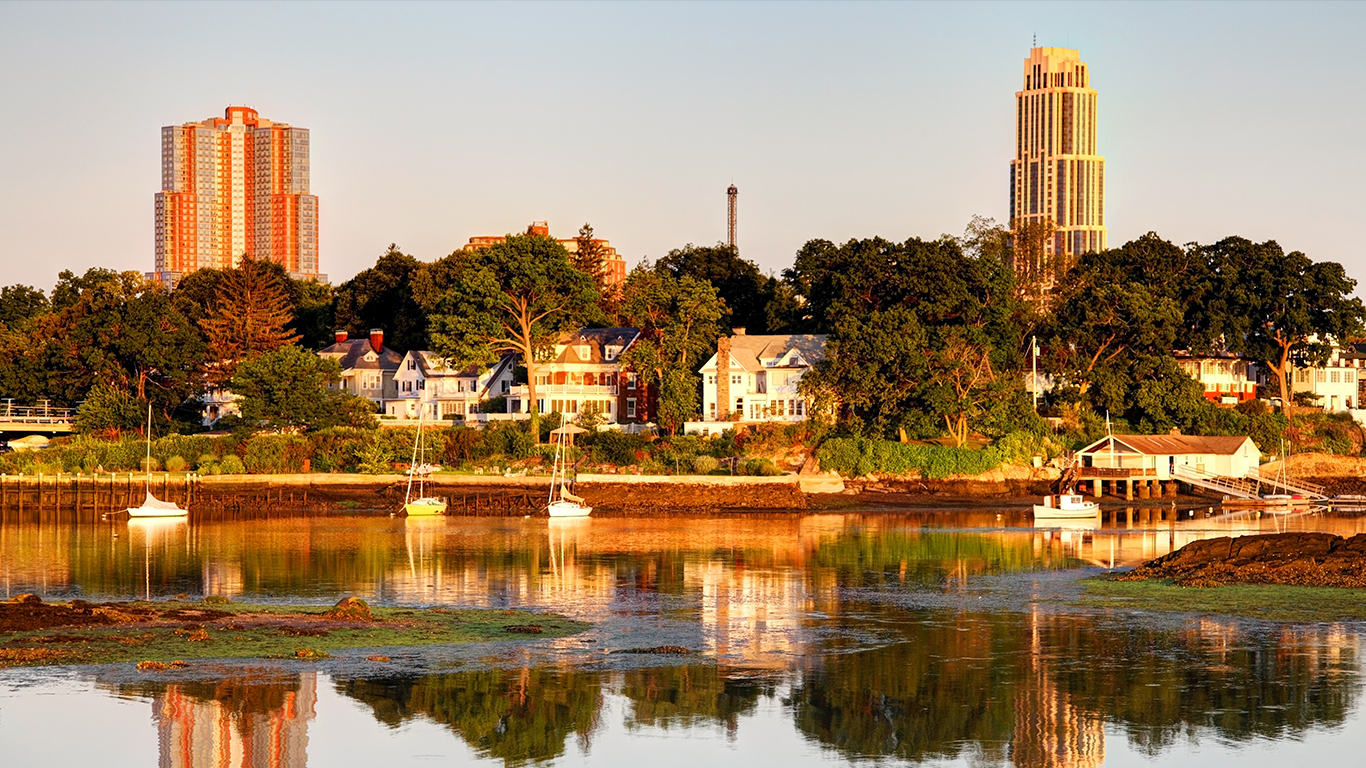
50. New Rochelle, New York
> Population: 79,558
> Median home value: $523,300 (top 10%)
> Poverty rate: 12.5% (bottom 25%)
> Pct. with at least a bachelor’s degree: 45.6% (top 25%)
New Rochelle is the only city in New York among the 50 best places to live in the United States. An estimated 19.4% of commuters in New Rochelle use public transportation, nearly four times the national share. Many of those commuting from New Rochelle travel on the Metro-North Railroad to high-paying jobs in New York City. The typical New Rochelle household earns $75,757 a year, far more than the $57,617 the typical American household earns a year.
In addition to providing access to the economic opportunities of a major metropolitan area, New Rochelle offers the quality of life of a wealthy suburb. The area has roughly one park and five golf courses per 100,000 residents, among the most of any city nationwide.
[in-text-ad]

49. Layton, Utah
> Population: 75,658
> Median home value: $235,000
> Poverty rate: 7.4% (bottom 10%)
> Pct. with at least a bachelor’s degree: 30.4%
Crime, poverty, and unemployment are less common in Layton than in the vast majority of U.S. cities. While nationwide there were 386 violent crimes reported per 100,000 Americans in 2016, in Layton there were just 156 incidents per 100,000 residents. Just 7.4% of Lawton residents live in poverty, and only 3.3% of the city’s workforce is unemployed, some of the lowest such figures in the country.
The wave of inbound migration to the city over the past five years is likely a reflection of its desirability. The population of Lawton increased 10.5% between 2011 and 2016, nearly three times the national rate.

48. Appleton, Wisconsin
> Population: 75,465
> Median home value: $143,000
> Poverty rate: 13.7%
> Pct. with at least a bachelor’s degree: 32.8%
Appleton is home to far more schools and cultural amenities per capita than most city in the country. There are approximately seven colleges and universities — including Lawrence University — per 100,000 residents. Appleton also boasts well over two times the concentration of restaurants, bars, fitness and recreation centers, and movie theatres than is typical nationwide.
Appleton’s layout also allows many of its residents to walk to work. An estimated 4.5% of Appleton residents commute by walking, nearly double the national average. The average commute in Appleton lasts just 18 minutes, roughly 9 minutes less than the U.S. figure.
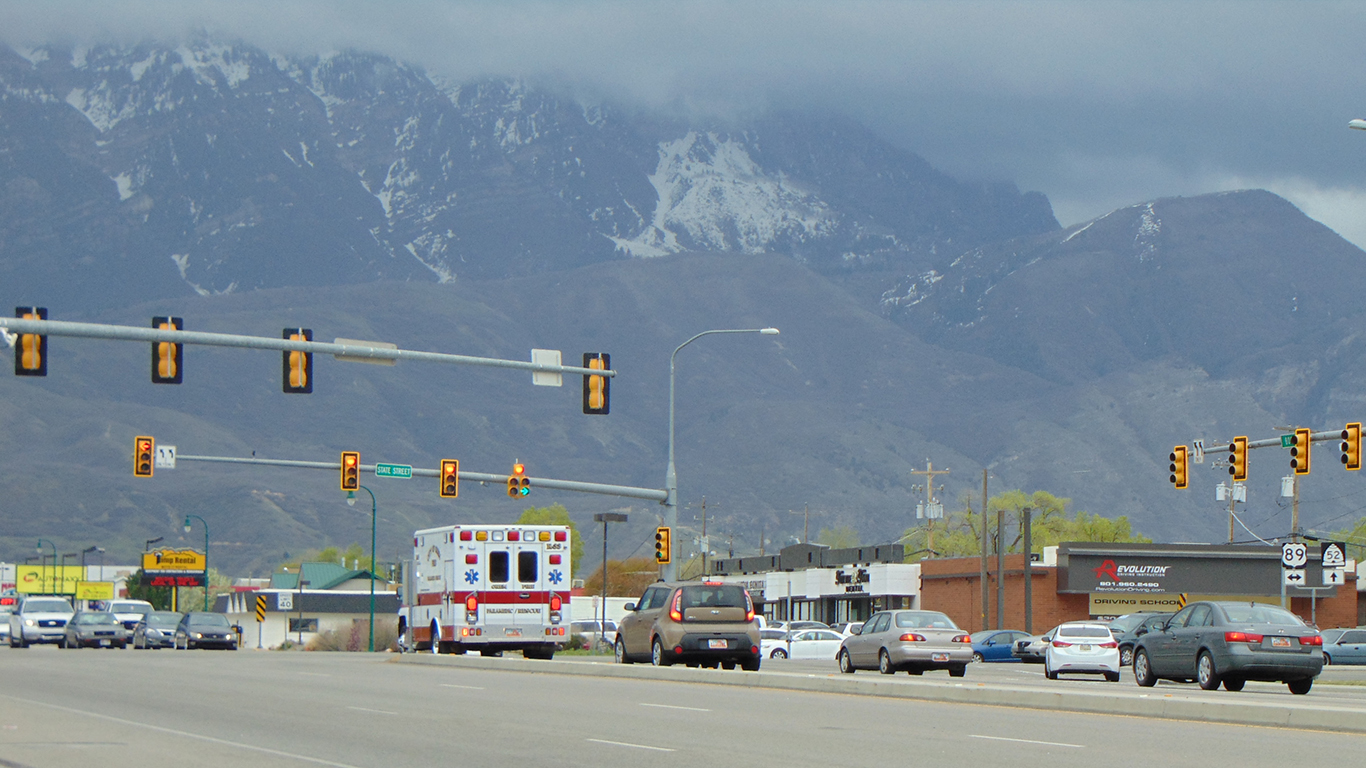
47. Orem, Utah
> Population: 97,508
> Median home value: $238,700
> Poverty rate: 11.9% (bottom 25%)
> Pct. with at least a bachelor’s degree: 36.8%
Orem, Utah has less crime and lower unemployment than nearly any other U.S. city. In 2016, there were just 67 violent crimes reported per 100,000 residents, far less than the national crime rate of 386 incidents per 100,000 Americans. Just 11.9% of residents live in poverty, and only 3.1% of the workforce is unemployed — each among the smaller shares of any U.S. city.
Orem is also one of many fast-growing mid-size cities in the United States. The Orem population increased by 7.5% between 2011 and 2016, more than twice the national growth rate. Between 2014 and 2016, the city’s workforce increased 10.2%, the 10th most of any city. One factor fueling economic growth in Orem is the Silicon Slopes, a growing cluster of technology companies in the Provo-Orem metropolitan area.
[in-text-ad-2]

46. South Jordan, Utah
> Population: 69,034
> Median home value: $385,300 (top 25%)
> Poverty rate: 4.1% (bottom 10%)
> Pct. with at least a bachelor’s degree: 34.1%
South Jordan is the best city to live in Utah and one of the best in the country. Two factors contributing to the high quality of life in South Jordan are the city’s low poverty and unemployment rates. Just 4.1% of residents live in poverty, and only 3.0% of the city’s labor force is unemployed, far less than the national 14.0% poverty rate and 4.9% unemployment rate.
South Jordan is also one of the fastest growing cities in the country. The working population increased 10.5% between 2014 and 2016, the eighth most of any U.S. city. One factor fueling the city’s rapid growth is the continued construction of the planned community known as Daybreak, which could nearly double South Jordan’s housing stock once completed.

45. Springdale, Arkansas
> Population: 81,799
> Median home value: $160,300
> Poverty rate: 15.6%
> Pct. with at least a bachelor’s degree: 23.0%
Many of the most desirable communities in the United States are growing rapidly — and Springdale, Arkansas is among them. The city’s population expanded by 25.5% over the last decade, more than three times the comparable U.S. population growth.
A healthy economy may partially explain Springdale’s rapid growth. The city’s 2.7% annual unemployment rate is lower than both the U.S. unemployment rate of 4.9% and the statewide rate of 4.0%. For those employed in Springdale, incomes are about 7% higher than they are across the state as a whole. A dollar also goes further than typical in Springdale. Goods and services cost about 17% less in the city than they do across the United States as a whole.
[in-text-ad]
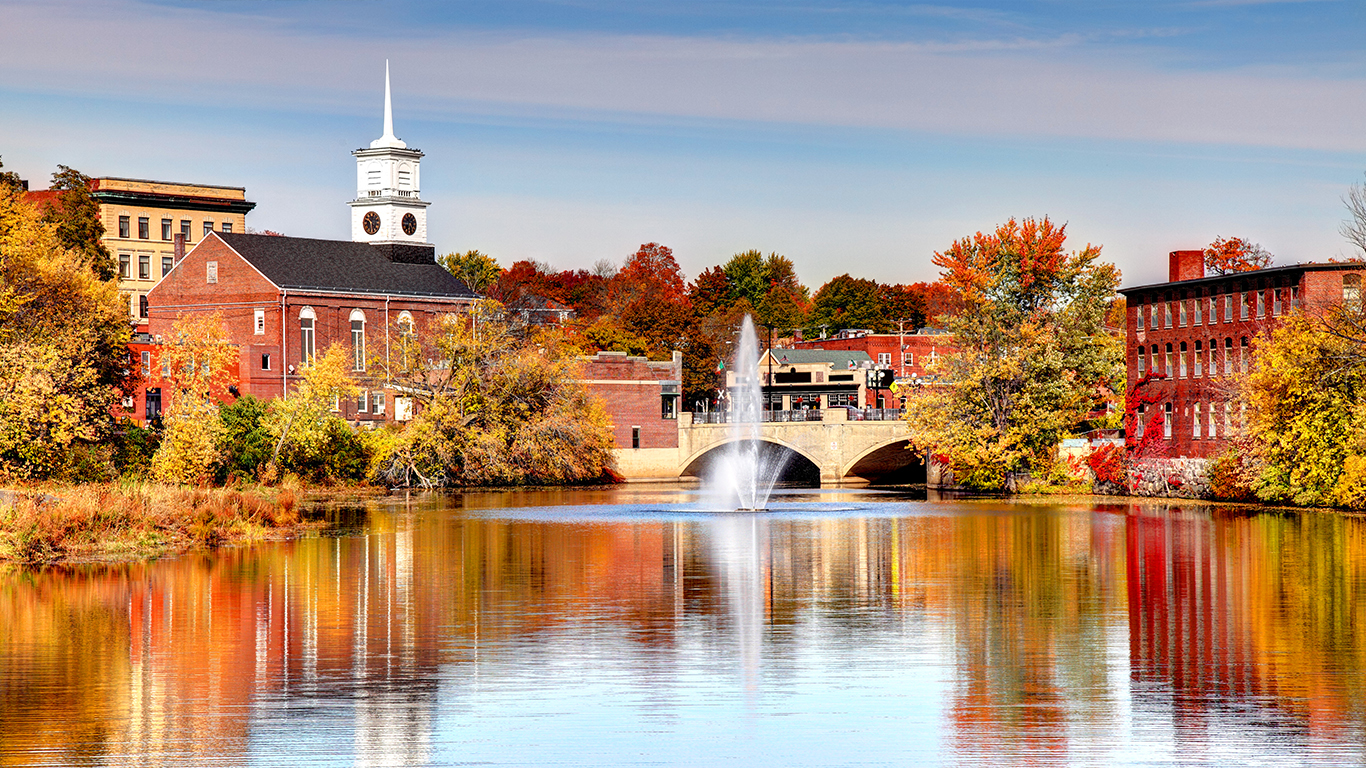
44. Nashua, New Hampshire
> Population: 87,889
> Median home value: $256,800
> Poverty rate: 9.1% (bottom 25%)
> Pct. with at least a bachelor’s degree: 31.3%
Residents of Nashua, New Hampshire benefit from a strong economy and a disproportionately high concentration of cultural amenities and entertainment venues. Only 3.3% of the local labor force is out of work, well below the 4.9% annual U.S. unemployment rate. Many of those working in Nashua are well compensated. The typical area household earns $69,769 a year, over $12,000 more than the typical American household.
Nashua residents have plenty of options when it comes to spending disposable income. There are 223 restaurants and cafes for every 100,000 residents, far more than the typical concentration nationwide. Nashua also boasts a greater than average concentration of recreation centers and sports teams.
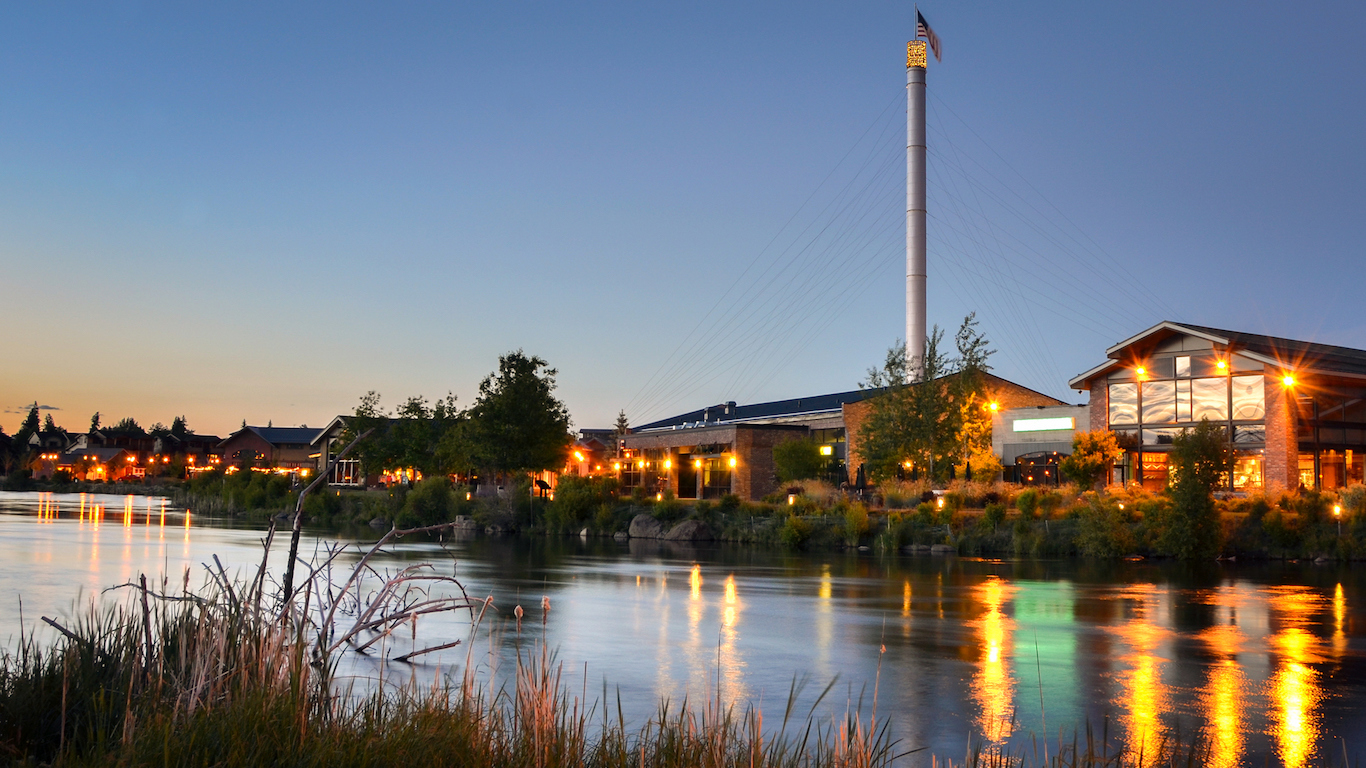
43. Bend, Oregon
> Population: 91,123
> Median home value: $347,300 (top 25%)
> Poverty rate: 10.4% (bottom 25%)
> Pct. with at least a bachelor’s degree: 40.2% (top 25%)
Bend is one of two Oregon towns to rank among the best in the country to live. High incomes and a low cost of living make the area especially attractive. The typical household earns $60,784 a year — about $3,000 more than the typical American household. Goods and services are also 2.6% less expensive in Bend on average than they are nationwide.
Bend’s population expanded by 24.2% over the last decade, more than three times the comparable U.S. population growth rate over that time. Job growth appears to be keeping pace. Employment in Bend climbed by 15.1% between 2014 and 2016, the most substantial employment growth of any U.S. city. Only 3.8% of Bend’s labor force is out of a job, well below the 4.9% U.S. annual unemployment rate.

42. Kirkland, Washington
> Population: 87,672
> Median home value: $582,100 (top 10%)
> Poverty rate: 6.6% (bottom 10%)
> Pct. with at least a bachelor’s degree: 62.3% (top 10%)
Many may know the name Kirkland from wholesaler Costco’s store brand, Kirkland Signature. The company was indeed once headquartered there. Even without Costco’s headquarters, the Seattle region city is home to a number of high-paying companies. Google notably has an office in the city. The presence of Google and other companies has contributed to Kirkland’s very high household incomes. The typical household in Kirkland earns $114,000 annually, almost double the nationwide median household income.
As is often the case, a well-educated workforce in the city accompanies an economy with high-paying, professional jobs. Over 60% of Kirkland’s adults have a college degree, nearly double the national college attainment rate.
[in-text-ad-2]
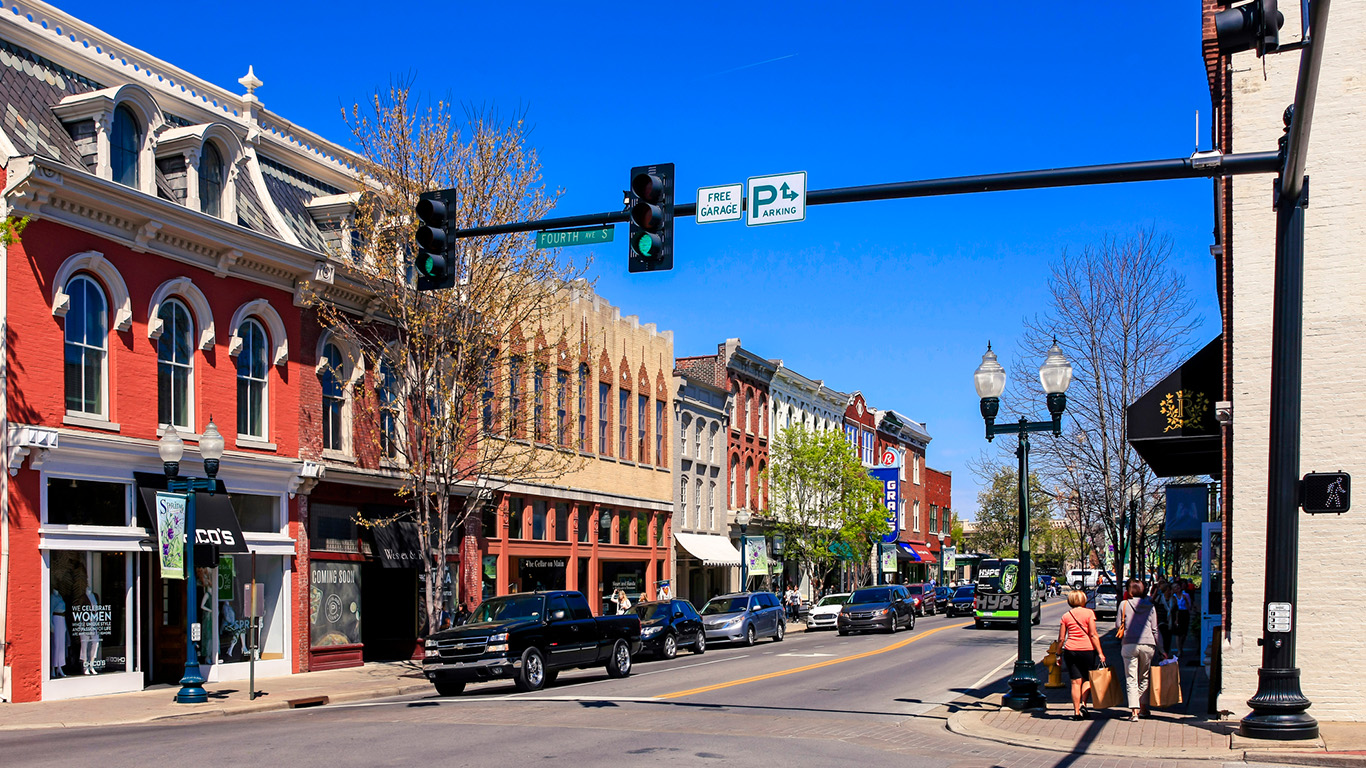
41. Franklin, Tennessee
> Population: 74,788
> Median home value: $391,000 (top 25%)
> Poverty rate: 10.1% (bottom 25%)
> Pct. with at least a bachelor’s degree: 58.5% (top 10%)
A weak economy can undercut any number of advantages an American city might have. Conversely, a strong economy can create a virtuous cycle in a community. In Franklin, Tennessee, a city with only 3.3% unemployment and an 8.4% uptick in total employment between 2014 and 2016 — more than double comparable U.S. employment growth rate — the economy is a boon.
A highly skilled workforce can be more resilient to economic slumps, and in Franklin, 58.5% of adults have at least a bachelor’s degree compared to only 31.3% of American adults. Better-educated populations also tend to be higher earning, and Franklin’s labor force is no exception. The typical area household earns $91,657 a year, or $34,000 more than the typical American household.

40. Clifton, New Jersey
> Population: 85,847
> Median home value: $345,100 (top 25%)
> Poverty rate: 8.6% (bottom 25%)
> Pct. with at least a bachelor’s degree: 34.1%
Many of the best cities to live in the United States are relatively expensive. No exception, Clifton, New Jersey’s cost of living is about 28% higher than it is nationwide. However, expensive goods and services in the area are largely offset by high incomes. The typical area household earns $77,923 a year — about $20,300 more than the median income nationwide. As is the case in many of the most liveable American cities, serious financial hardship is relatively uncommon in Clifton. Only 8.6% of area residents live below the poverty line, below both the statewide poverty rate of 10.4% and the U.S. rate of 14.0%.
A part of the New York City metro area, Clifton residents have easy access to the cultural amenities of the country’s largest city, including easy access to transportation. The New York metro area boasts the most airports and the nation’s highest public transit usage rate.
[in-text-ad]

39. Palm Coast, Florida
> Population: 88,337
> Median home value: $198,700
> Poverty rate: 11.7% (bottom 25%)
> Pct. with at least a bachelor’s degree: 20.8% (bottom 25%)
The typical household in Palm Coast, Florida earns $49,371 a year, considerably less than the typical American household income of $57,617 a year. Though incomes are lower on average in Palm Coast, a large share of the population appears to live relatively comfortably as comparatively few residents face serious financial hardship. Only 11.7% of Palm Coast residents live in poverty, below the statewide and nationwide poverty rates of 14.7% and 14.0%, respectively.
As is the case with many cities on this list, Palm Coast’s population is expanding rapidly. The city’s population grew by 23.7% in the last decade — more than triple U.S. population growth over the same period. New residents also appear to be fueling job growth. The area’s employment climbed 6.0% between 2014 and 2016, well above the 3.5% U.S. employment growth rate.

38. Mount Pleasant, South Carolina
> Population: 84,177
> Median home value: $437,000 (top 10%)
> Poverty rate: 4.2% (bottom 10%)
> Pct. with at least a bachelor’s degree: 57.9% (top 10%)
Mount Pleasant, South Carolina is one of only seven large U.S. cities with a median income more than double that of its home state. One of the wealthiest cities in the country, Mount Pleasant’s median income of $101,015 is well above the median household income across South Carolina of $49,501 a year. The area’s affluence is underscored by the relative low poverty level. Only 4.2% of Mount Pleasant’s population lives below the poverty line, less than one-third of both the statewide and U.S. poverty rates.
The Mount Pleasant area is also rich in cultural amenities. The city boasts a higher concentration of museums, recreation centers, movie theatres, and nature parks than is typical nationwide. Residents also have easy access to jobs, culture, and entertainment in Charleston, South Carolina’s largest city.

37. Beaverton, Oregon
> Population: 97,602
> Median home value: $363,100 (top 25%)
> Poverty rate: 9.6% (bottom 25%)
> Pct. with at least a bachelor’s degree: 44.8% (top 25%)
Beaverton, which is part of the Portland metropolitan area, is the best city in Oregon to live in. For those looking for job prospects, few cities are likely to offer more opportunities than Beaverton, which is a 15-20 minute drive from downtown Portland. Over the last two years, employment in Beaverton has increased by 8.3%, faster than in all but a few dozen other U.S. cities. The national job growth rate over the same period was 3.5%.
Living in one of the healthiest states, Beaverton’s population is one of the healthiest in the country. The city has one of the lowest rates of preventable hospitalizations in both the state and the country.
[in-text-ad-2]
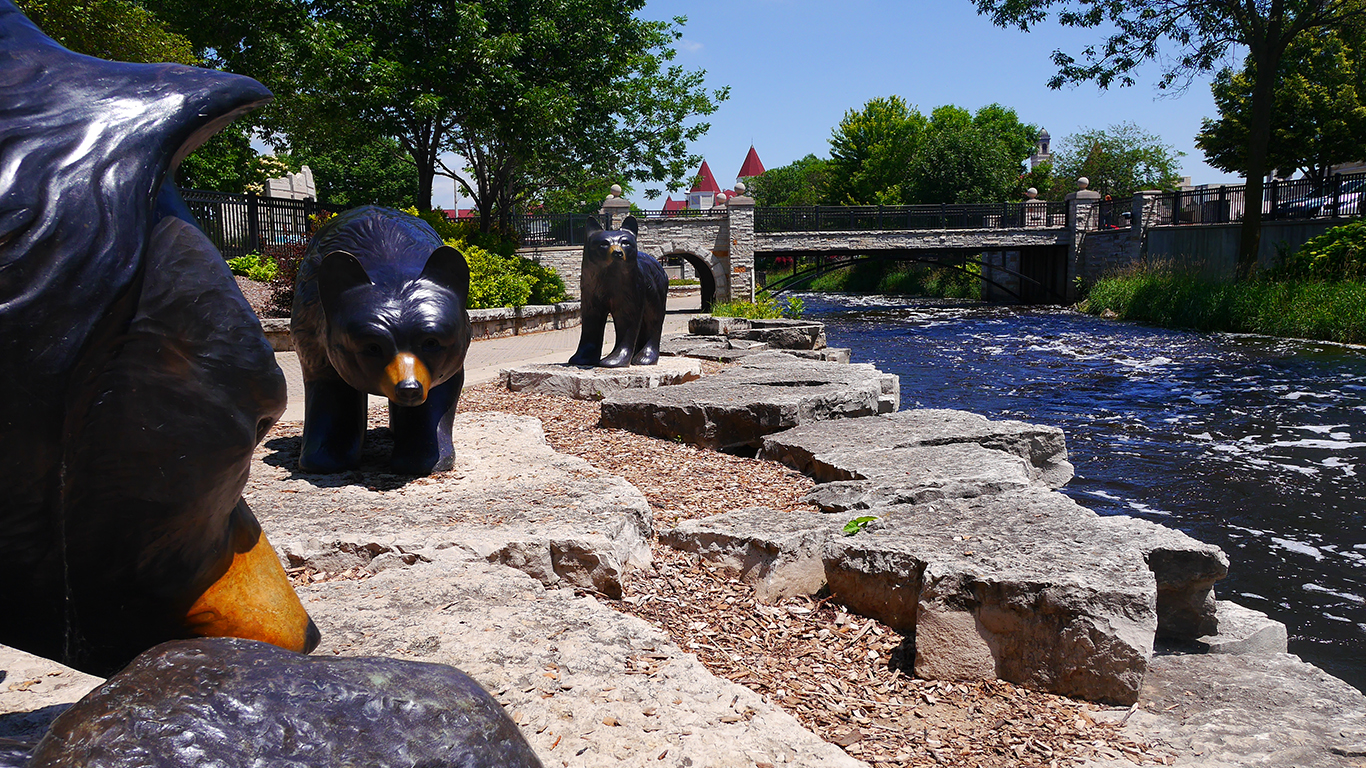
36. Waukesha, Wisconsin
> Population: 72,358
> Median home value: $196,100
> Poverty rate: 12.7% (bottom 25%)
> Pct. with at least a bachelor’s degree: 34.9%
The Milwaukee metro area city of Waukesha is the most liveable city in Wisconsin and one of the best cities in which to live in the United States. Area residents have access to higher concentrations of restaurants, bars, fitness centers, and movie theatres than is typical nationwide.
Though the median household income in Waukesha of at $56,808 is roughly in line with that of the nation as whole, poverty is slightly less common in the area. Only 12.7% of residents live below the poverty line compared to 14.0% of Americans. The city is also relatively safe. There were only 127 violent crimes in Waukesha in 2016 for every 100,000 people, a third of the comparable U.S. crime rate.
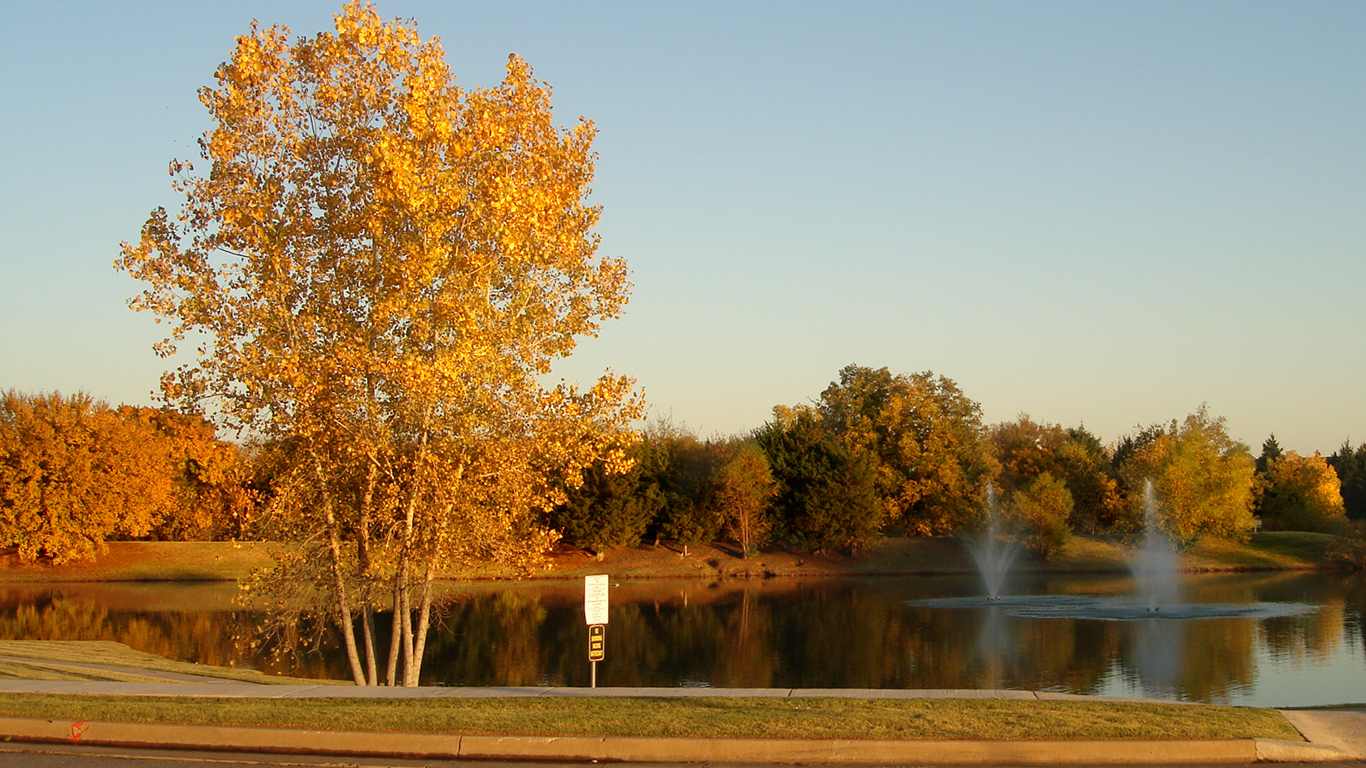
35. Edmond, Oklahoma
> Population: 91,187
> Median home value: $221,600
> Poverty rate: 10.6% (bottom 25%)
> Pct. with at least a bachelor’s degree: 54.7% (top 10%)
Oklahoma is one of the lowest-income states in the country — the typical household brings in less than $50,000 annually. However, in Edmond, which is part of the greater Oklahoma City region, the typical household earns an income of over $95,000 each year. The incomes of these households likely goes further than in other affluent parts of the country. Goods and services in the region cost only about 83 cents on the dollar compared to national average prices. Health and housing costs are particularly inexpensive in the region.
At just 3.2% of the labor force in 2016, Edmond has one of the lowest unemployment rates among metropolitan areas. The national annual unemployment rate is 4.9%.
[in-text-ad]
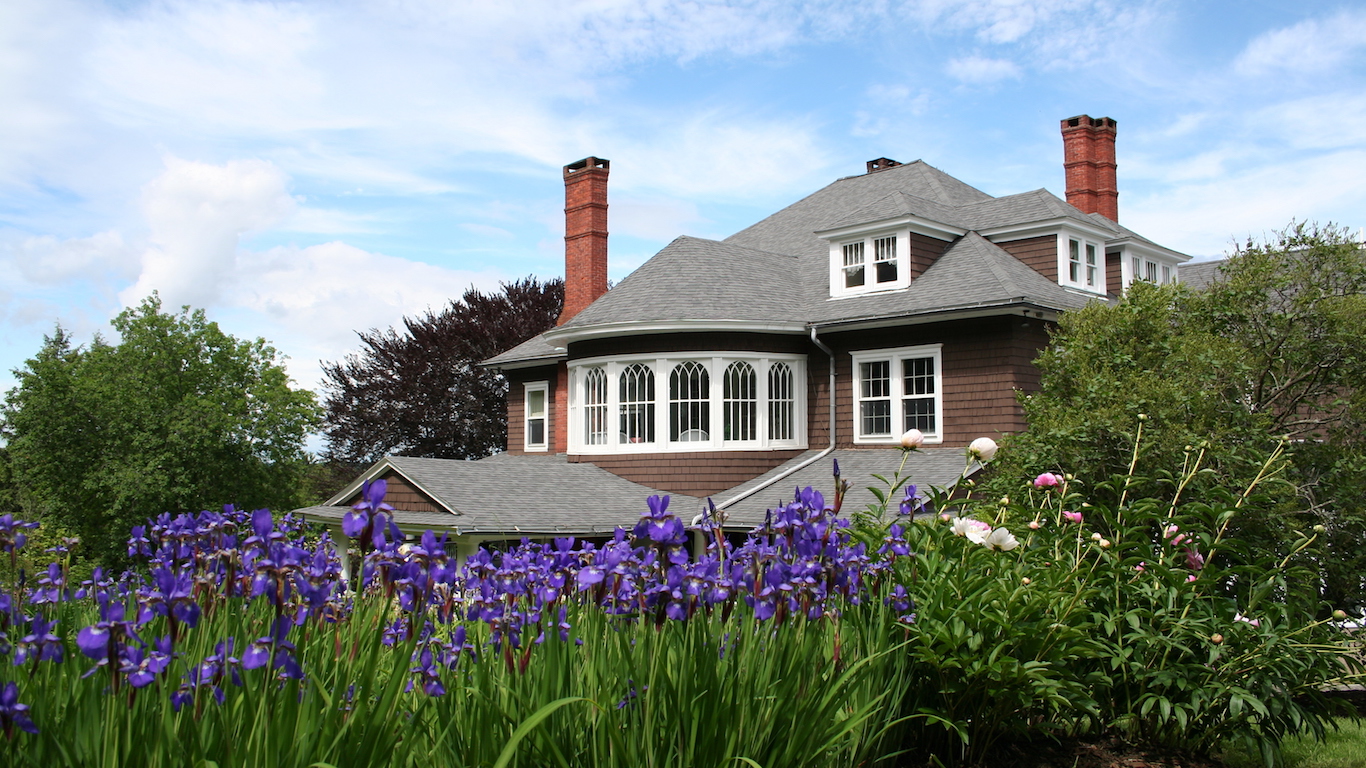
34. Danbury, Connecticut
> Population: 85,008
> Median home value: $297,600 (top 25%)
> Poverty rate: 8.9% (bottom 25%)
> Pct. with at least a bachelor’s degree: 31.3%
Located in Fairfield County, Connecticut, Danbury is one of the most expensive places in the United States. Goods and services cost an average of 30.8% more than in the area than they do nationwide. Though the median income in Danbury is nearly $13,000 higher than it is nationwide, bigger paychecks are not enough to offset the area’s high cost of living.
Despite the high cost of living, based on a range of socioeconomic measures, Danbury is the most livable city in Connecticut and one of the most livable in the United States. Danbury boasts a higher concentration of restaurants, sports teams, and theatre companies than is typical nationwide. For physically active residents, the city also has a relatively high concentration of recreation centers, golf courses, and nature parks.

33. Lawrence, Kansas
> Population: 95,355
> Median home value: $191,500
> Poverty rate: 20.0%
> Pct. with at least a bachelor’s degree: 57.1% (top 10%)
Lawrence, Kansas is home to the University of Kansas, the largest higher education institute in the state with over 30,000 students. KU’s presence might help explain the area’s extremely high educational attainment. While about 31% of American adults have a college education, 57% do in Lawrence. A college degree often leads to higher-paying jobs and also has been shown to have other positive effects, including giving individuals a greater sense of control over their lives.
Lawrence compares favorably to the rest of the country in several measures, including unemployment and the concentration of local attractions and amenities. Still, the city is not perfect. For example, job growth in the city has been slower than in most major cities over the past two years.
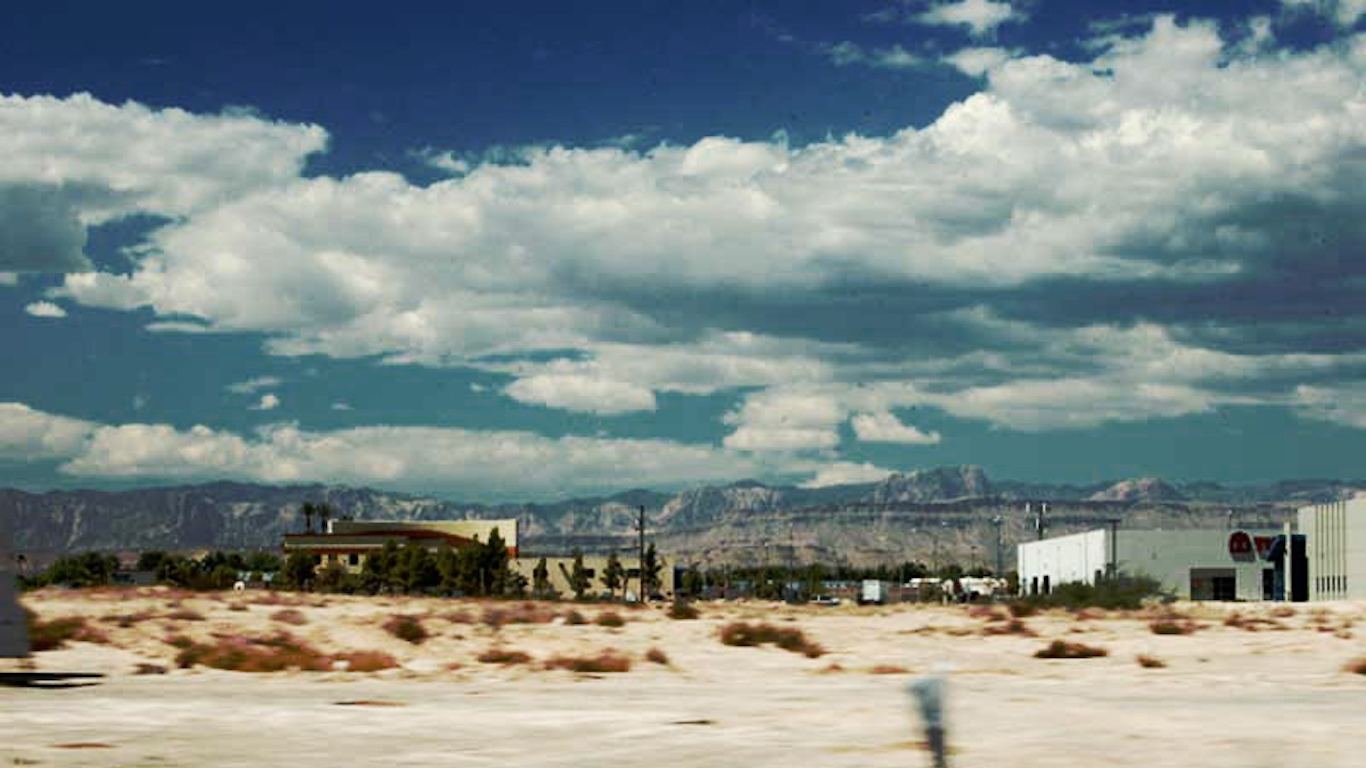
32. Enterprise, Nevada
> Population: 139,509
> Median home value: $269,000
> Poverty rate: 7.8% (bottom 10%)
> Pct. with at least a bachelor’s degree: 29.2%
With an 80% population growth in the last 10 years, Enterprise, Nevada is the second fastest growing city in the United States by population. The city’s population boom is not without just cause. Slightly less expensive the nation as a whole, both housing and health care costs are about 6% cheaper than the average comparable costs nationwide. The area’s less expensive housing is partially attributable to low property taxes. Typical area homeowners pay only 0.7% of their home value in property taxes — slightly less than the 1.1% share paid by typical homeowners on a national scale.
Poverty is relatively low in Enterprise. The city’s 7.8% poverty rate is the lowest of all major cities in Nevada and well below the 14.0% U.S. rate.
[in-text-ad-2]
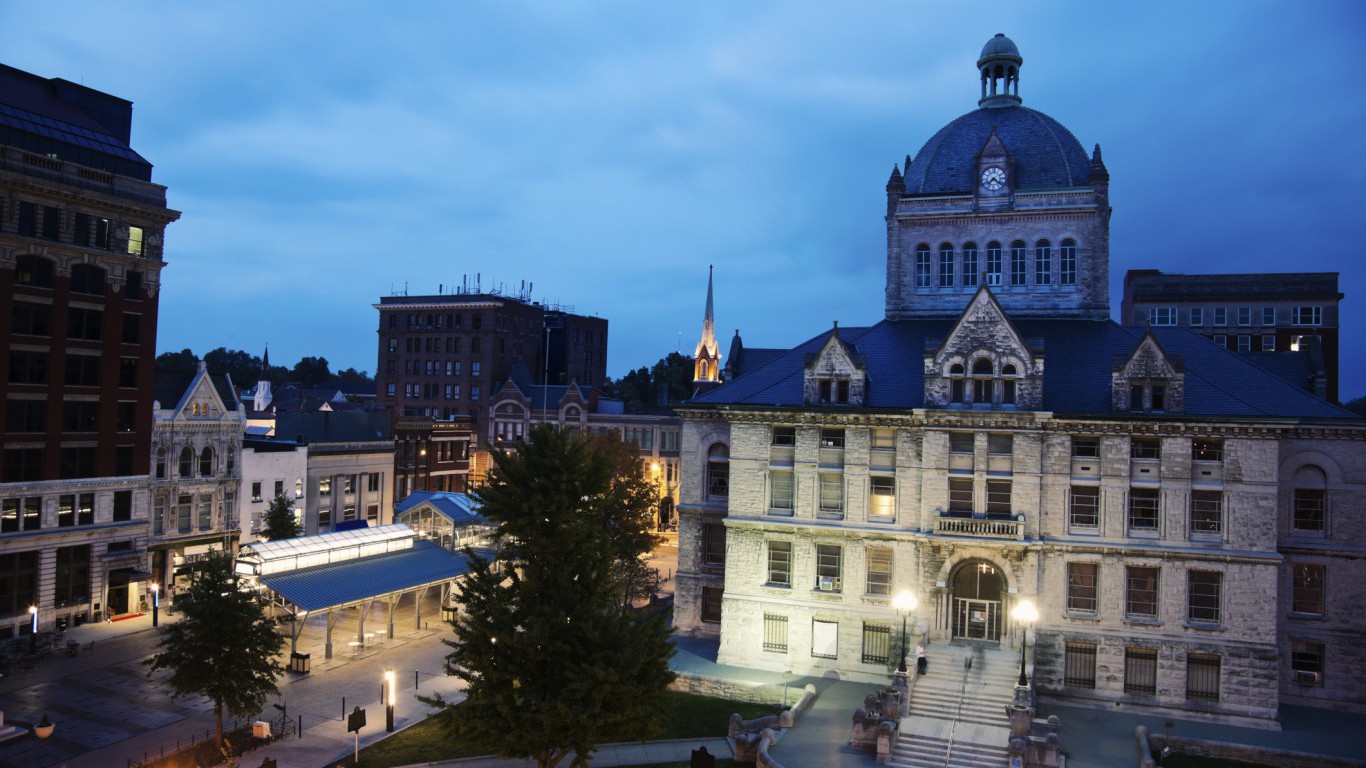
31. Lexington-Fayette, Kentucky
> Population: 318,449
> Median home value: $181,200
> Poverty rate: 17.7%
> Pct. with at least a bachelor’s degree: 43.7% (top 25%)
Many of the best cities to live in are college towns. Lexington-Fayette is home to the University of Kentucky, the largest post secondary institution in the state.
In 1958, the City of Lexington instituted the first urban growth boundary in the United States in order to limit sprawl development and preserve the city’s outlying farmland. The boundary has helped preserve the area’s numerous thoroughbred horse farms and create a culture of horse racing and equestrian events. Today, Lexington is home to two horse racing tracks, and economic activities related to horses generate approximately $4 billion in the area annually.

30. Weston, Florida
> Population: 70,023
> Median home value: $455,700 (top 10%)
> Poverty rate: 7.2% (bottom 10%)
> Pct. with at least a bachelor’s degree: 59.3% (top 10%)
Weston, Florida, located on the far western edge of the Fort Lauderdale metro area adjacent to the Everglades, is a planned city. It is also an expensive place to live compared to average U.S. costs. Goods and services on the whole cost about 19 cents more on the dollar compared to the national average, and utilities are roughly double the cost.
However, Weston residents are, on the whole, more than capable of covering the additional expenses. The typical household earns over $100,000 annually, well above the $57,600 median household income nationwide. Even when adjusting for living costs, Weston’s median income is still considerably higher than that of most metropolitan areas.
[in-text-ad]
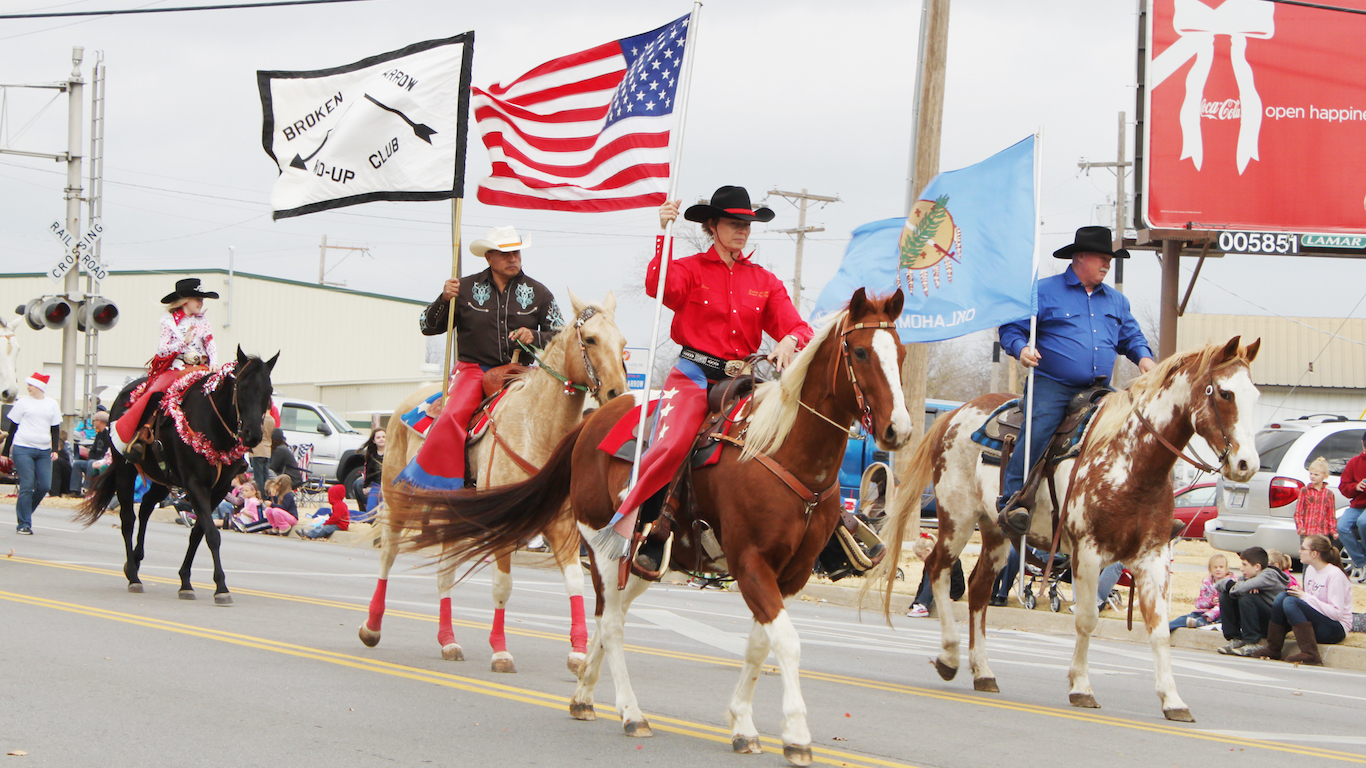
29. Broken Arrow, Oklahoma
> Population: 109,439
> Median home value: $160,900
> Poverty rate: 8.6% (bottom 25%)
> Pct. with at least a bachelor’s degree: 35.3%
The best city to live in in Oklahoma, Broken Arrow also has the state’s fastest growing population. Broken Arrow’s population has increased by 18.6% in the last 10 years — more than double the comparable U.S. population growth over that time. Residents of Broken Arrow likely appreciate the area’s relative safety. While much of Oklahoma is at high risk of tornadoes, Broken Arrow has the lowest risk of natural disaster of any other major city in the state. Violent crime is also relatively uncommon. There were only 154 violent crimes for every 100,000 people in the city in 2016, nearly a third of the statewide violent crime rate.

28. Eagan, Minnesota
> Population: 66,431
> Median home value: $274,400
> Poverty rate: 6.0% (bottom 10%)
> Pct. with at least a bachelor’s degree: 51.2% (top 10%)
Compared to the country as a whole, Minnesota has relatively little poverty. The state’s poverty rate of 9.9% is fifth lowest of U.S. states. In Eagan, which is part of the Minneapolis-St. Paul metropolitan area, just 6.0% of the population live at or below the poverty line. Eagan has a well-educated population, with over half of the city’s adults holding at least a bachelor’s degree. The city’s high school students also score better on standardized tests than students in the vast majority of Minnesota cities.
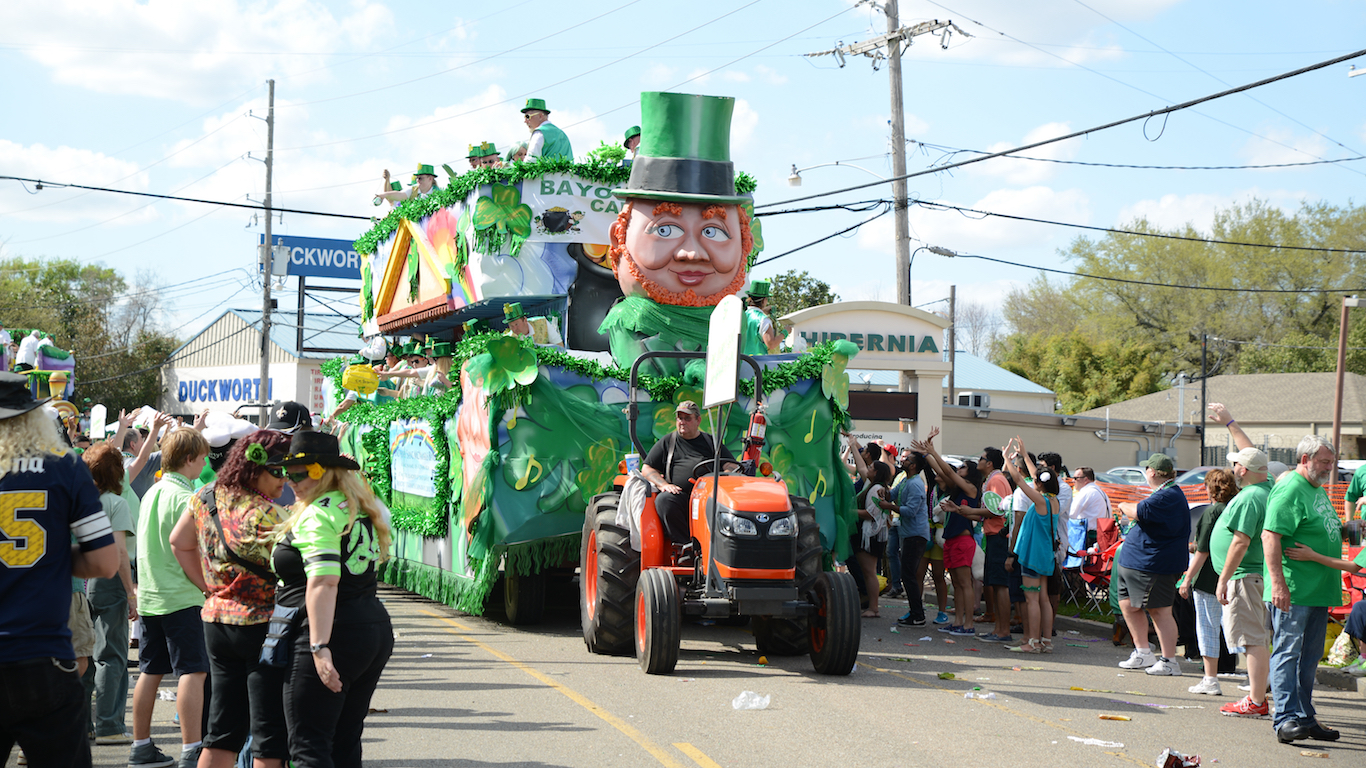
27. Metairie, Louisiana
> Population: 143,475
> Median home value: $231,100
> Poverty rate: 9.6% (bottom 25%)
> Pct. with at least a bachelor’s degree: 37.1%
One of the poorest states in the country, Louisiana’s poverty rate of 20.2% is nearly the highest of any state. However, serious financial hardship is far less common in some parts of the state. In Metairie, the most liveable city in the state and one of the most liveable cities in the United States, the poverty rate is less than half the statewide rate.
For those with disposable income in Metairie, the city boasts a dense concentration of cultural amenities and entertainment venues. There are far greater concentrations of restaurants, bars, fitness centers, and sports teams in Metairie than is typical nationwide.
[in-text-ad-2]
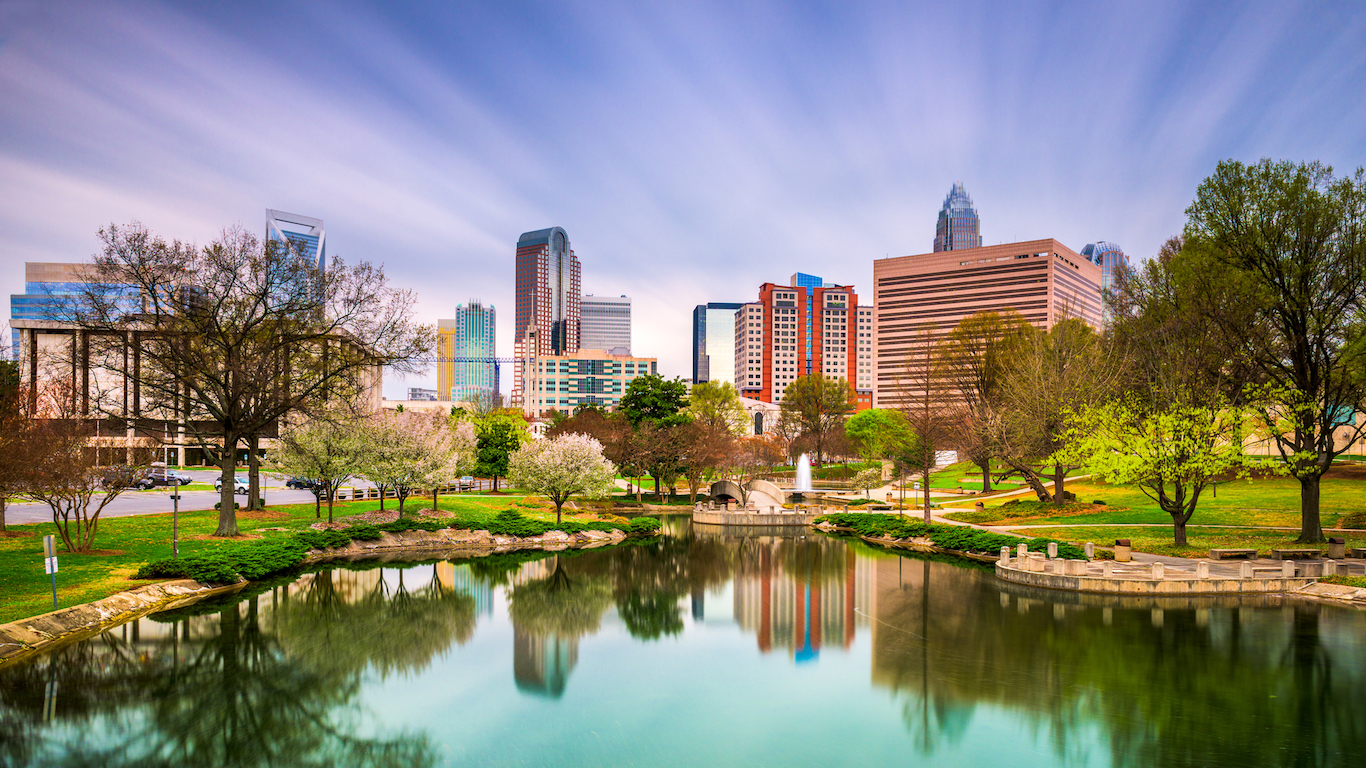
26. Charlotte, North Carolina
> Population: 842,029
> Median home value: $201,500
> Poverty rate: 13.4%
> Pct. with at least a bachelor’s degree: 44.1% (top 25%)
Charlotte is one of two cities in North Carolina with populations expanding at a near nation-leading pace and are among the 50 best places to live. Charlotte’s population increased by 24.7% over the past 10 years, more than three times the U.S. growth rate and the most of any city in North Carolina other than Raleigh or Cary.
Charlotte’s rapid growth is largely supported by a prosperous economy. North Carolina was one of the first states to allow banks to operate multiple branches within a single state, a regulation that led to banks rapidly expanding throughout Charlotte and the surrounding region. Today, Charlotte is home to the headquarters of Bank of America and the East Coast operations of Wells Fargo. Financial services is one of many sectors leading employment growth in the city, which was more than double the U.S. employment growth rate from 2014 to 2016. Charlotte is also home to numerous entertainment amenities including an NFL team, an NBA team, and the Carowinds amusement park.
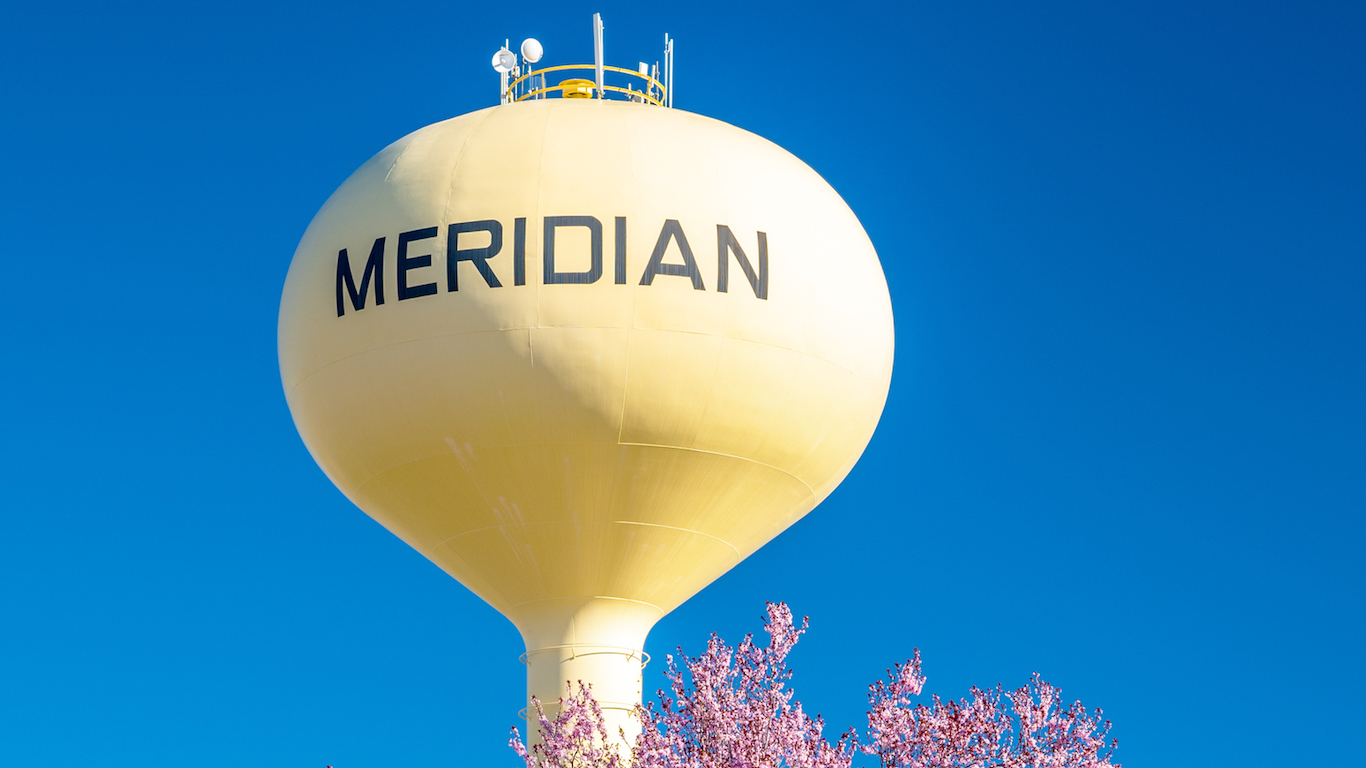
25. Meridian, Idaho
> Population: 95,627
> Median home value: $236,200
> Poverty rate: 6.2% (bottom 10%)
> Pct. with at least a bachelor’s degree: 36.7%
Meridian, Idaho’s population increased by 24.6% over the last five years — faster than in all but a handful of other U.S. cities and many times faster than the U.S. population growth rate of 3.7% over the same period. The city’s strong economy does not likely hurt its appeal. For example, total employment in Meridian climbed 8.7% from 2014 through 2016, more than double the comparable job growth rate nationwide. As of 2016, only 3.3% of Meridian’s workforce were out of a job compared to the 3.8% statewide and 4.9% nationwide unemployment rates.
Rapid job growth and low unemployment are often characteristics of relatively safe places — and Meridian is no exception. The city’s violent crime rate of 109 incidents per 100,000 people is less than one third the statewide rate and less than a third the U.S. violent crime rate.
[in-text-ad]
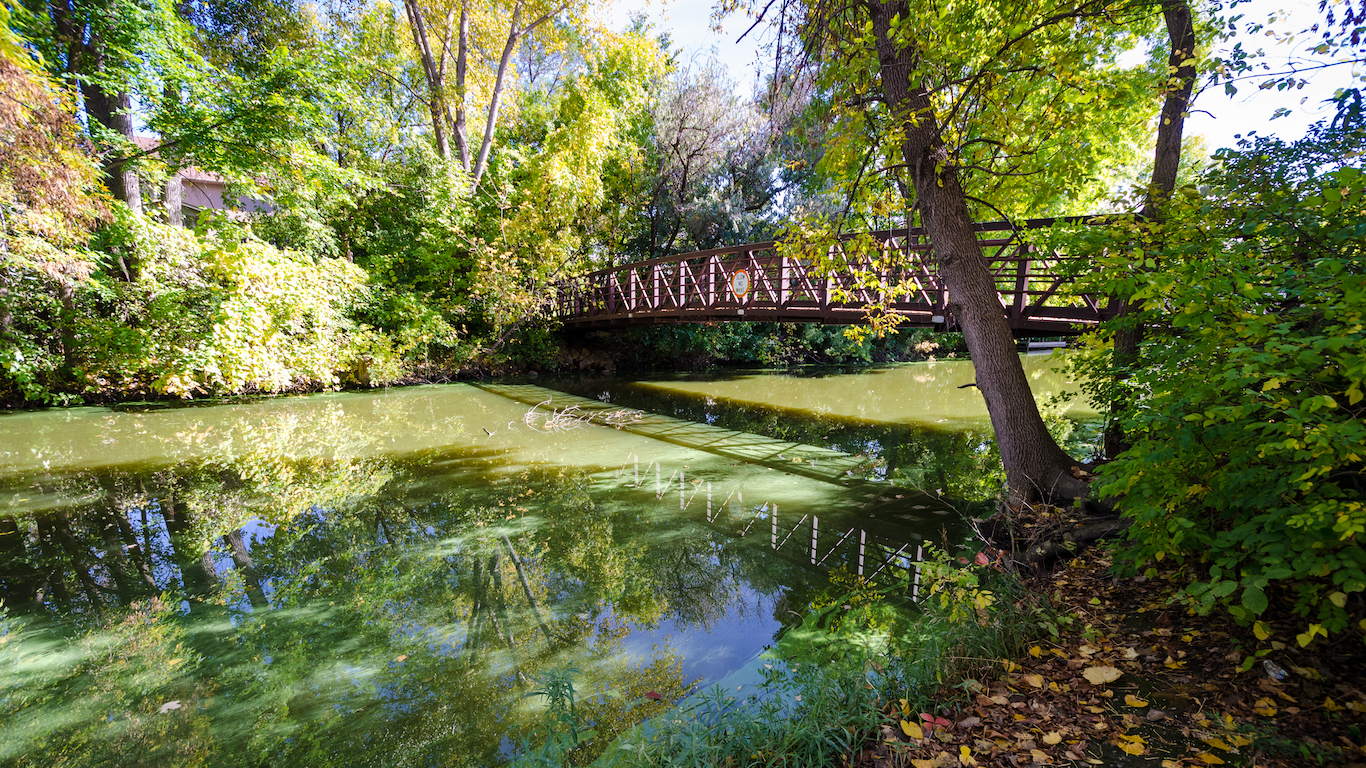
24. Maple Grove, Minnesota
> Population: 69,569
> Median home value: $284,200
> Poverty rate: 2.0% (bottom 10%)
> Pct. with at least a bachelor’s degree: 54.3% (top 10%)
A wealthy suburb of Minneapolis, Maple Grove is one of the best places to live. The typical Maple Grove household earns $113,957 a year, far more than the national median household income of $57,617. The city is also home to numerous amenities. There are twice as many fitness and recreational sports centers and movie theaters per 100,000 residents compared to the national average.
While neighboring Minneapolis has nearly three times as many violent crimes per capita as the nation as a whole, Maple Grove is one of the safest places to live in the country. There were 63 violent crimes reported per 100,000 Maple Grove residents in 2016, far less than 386 incidents reported per 100,000 Americans nationwide.
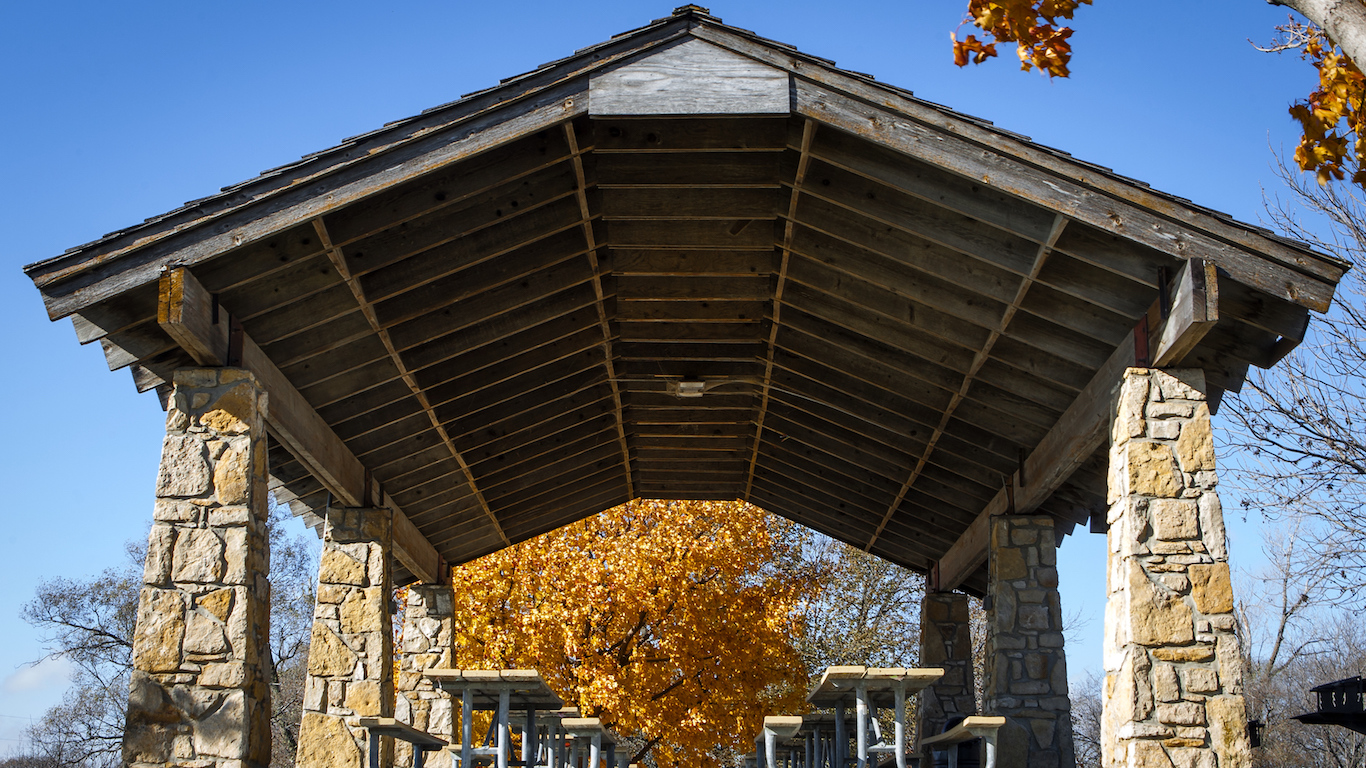
23. Olathe, Kansas
> Population: 135,474
> Median home value: $217,300
> Poverty rate: 5.6% (bottom 10%)
> Pct. with at least a bachelor’s degree: 49.6% (top 10%)
Poverty is quite low in Olathe, Kansas. Only 5.6% of city residents live below the poverty line, less than half the statewide poverty rate of 12.2%. The area’s relative financial security is due in part to a strong job market. Only 3.2% of Olathe’s workforce are out of a job, well below the 4.2% statewide unemployment rate and the 4.9% U.S. rate.
The city is also far more affordable than most. The typical home in Olathe costs only 2.6 times the area’s median household income. Nationwide, the typical home is worth 3.6 times the typical income.
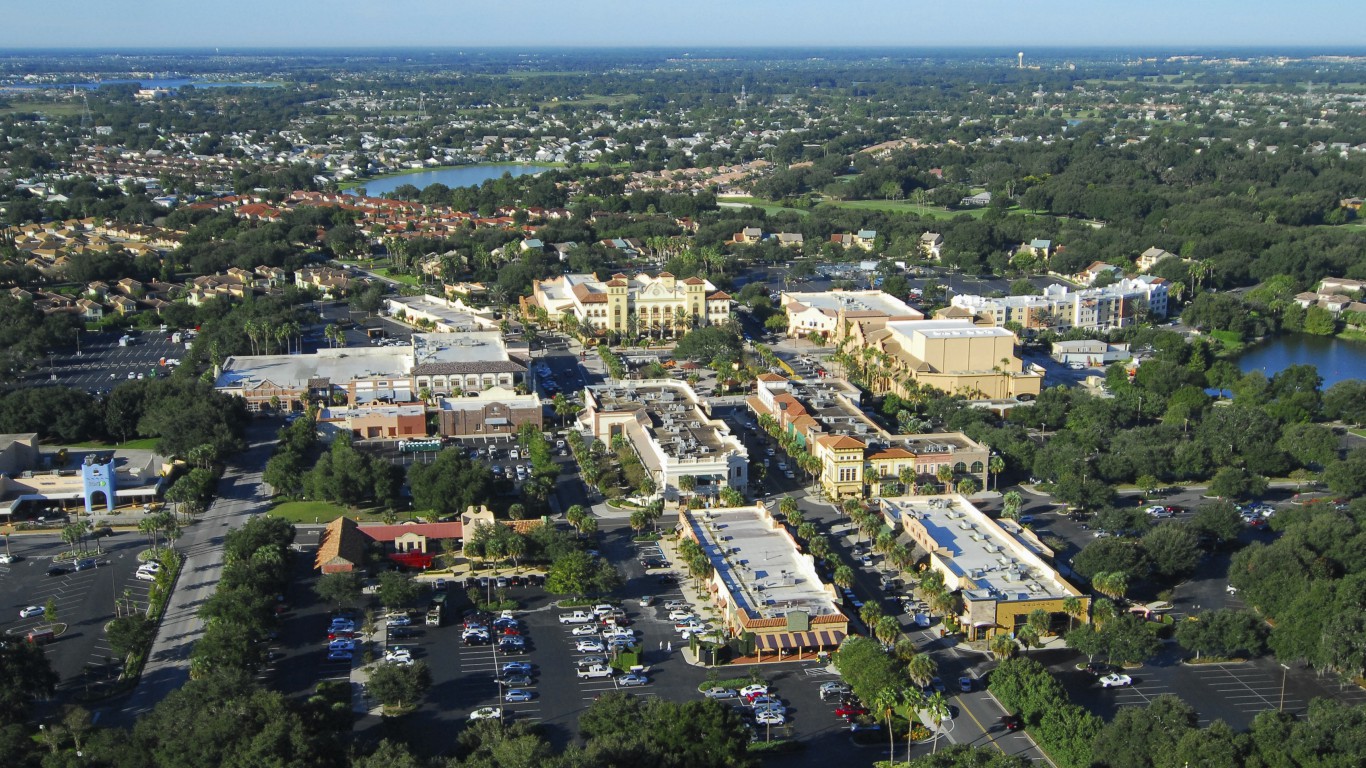
22. The Villages, Florida
> Population: 71,350
> Median home value: $274,600
> Poverty rate: 5.8% (bottom 10%)
> Pct. with at least a bachelor’s degree: 40.4% (top 25%)
The Villages largely consists of the master-planned, age-restricted community by the same name. An estimated 91% of The Villages population is 60 years old and above, The Villages’ elderly population enjoys nearly the highest quality of life of any city. Although more than half the households subsist on retirement income, the typical household in the census-designated place earns $61,220 a year, or roughly $4,000 more than the national median household income. The community is also home to numerous amenities and has more than twice as many nature parks per capita as the U.S. as a whole and among the most golf courses per person of any city.
The nation’s elderly comprise the fastest growing age segment in the United States. From 2010 to 2016, the number of residents in The Villages rose by 76.9%, more than in nearly any other city in the country.
[in-text-ad-2]
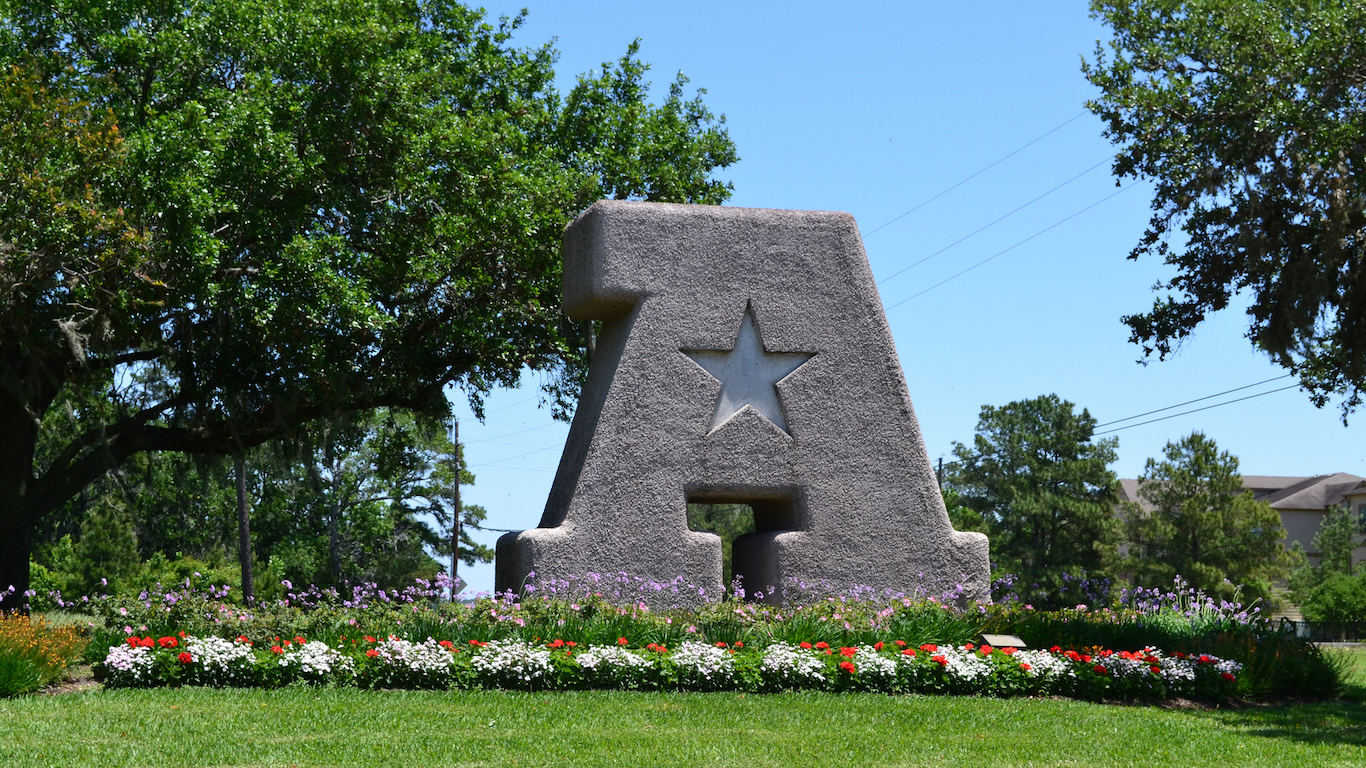
21. Atascocita, Texas
> Population: 72,763
> Median home value: $182,000
> Poverty rate: 4.2% (bottom 10%)
> Pct. with at least a bachelor’s degree: 39.6% (top 25%)
At only 4.2%, the poverty rate in Atascocita, Texas is one of the lowest of any U.S. city. Adults with a college education are less likely than those with lower educational attainment to live in poverty, and 39.6% of adult city residents have a four-year college degree, a far greater share than the 31.3% of American adults.
Well-educated and financially secure, Atascocita’s population also lives in an affordable city. The typical area home costs only 1.9 times the median household income in the area. Nationwide, the median home value is 3.6 times the median household income.
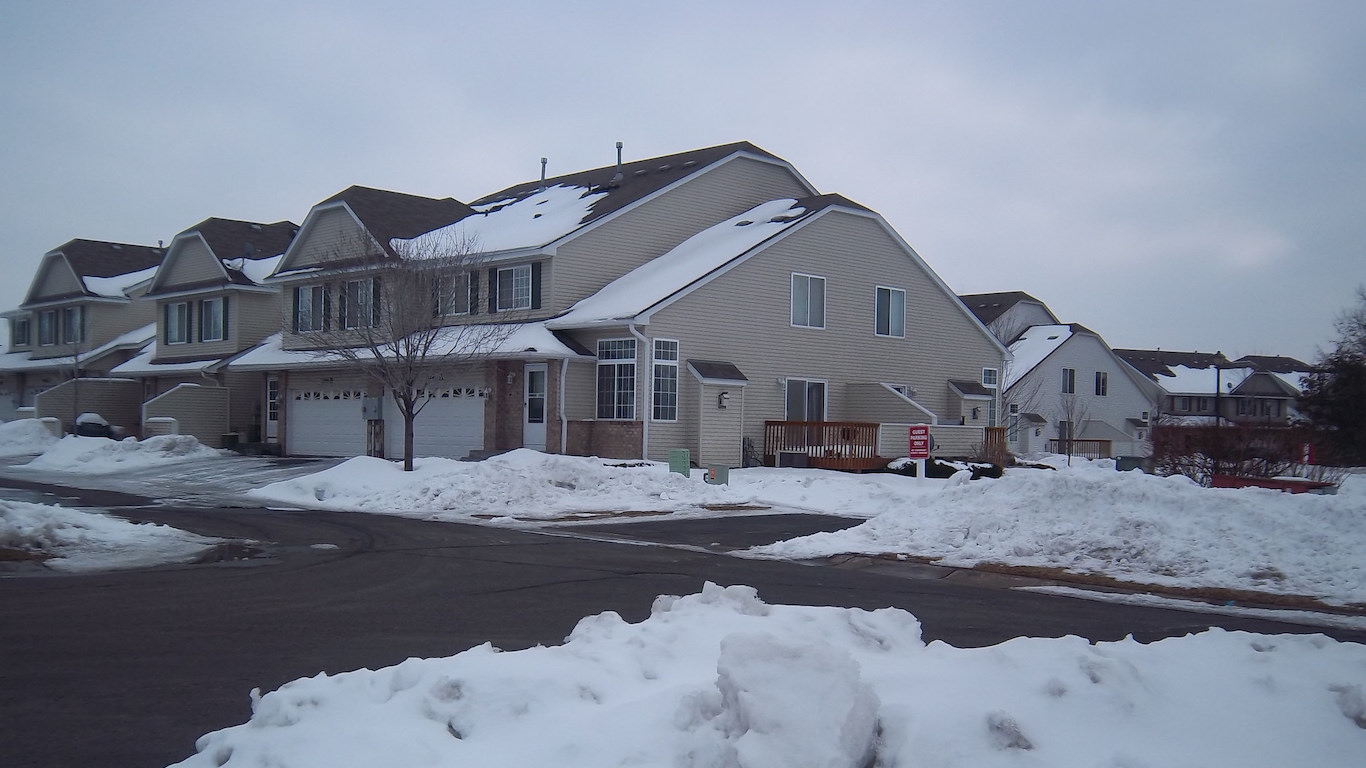
20. Woodbury, Minnesota
> Population: 68,824
> Median home value: $314,700 (top 25%)
> Poverty rate: 2.3% (bottom 10%)
> Pct. with at least a bachelor’s degree: 57.6% (top 10%)
Woodbury has less poverty and unemployment than nearly any other large U.S. city. Just 2.3% of city residents live in poverty, the second smallest share in the United States. The Woodbury unemployment rate of 3.0% is far lower than the national jobless rate of 4.9%.
Woodbury is also one of the most educated cities in the country. High schoolers in Woodbury test better than students in any other city in Minnesota, and 57.6% of adults have at least a bachelor’s degree — far more than the 31.3% national rate.
[in-text-ad]

19. Lee’s Summit, Missouri
> Population: 95,782
> Median home value: $209,100
> Poverty rate: 7.1% (bottom 10%)
> Pct. with at least a bachelor’s degree: 44.8% (top 25%)
For many Americans, an ideal city is safe and affordable with a healthy job market. Lee’s Summit, Missouri is one such city. There were only 109 violent crimes in Lee’s Summit for every 100,000 residents in 2016, a fraction of the state and national violent crime rates last year. Low housing costs also leave area residents with more disposable income. The typical area home is worth only 2.5 times the city’s median household income. In comparison, the typical U.S. home is worth about 3.6 times the median income nationwide.
A weak job market can cripple any U.S. city. However, in Lee’s Summit, only 3.5% of the labor force is out of a job, well below the state and U.S. annual unemployment rates of 4.5% and 4.9%, respectively. Situated in the Kansas City metro area, Lee’s Summit residents have access to jobs in the largest city in the state.
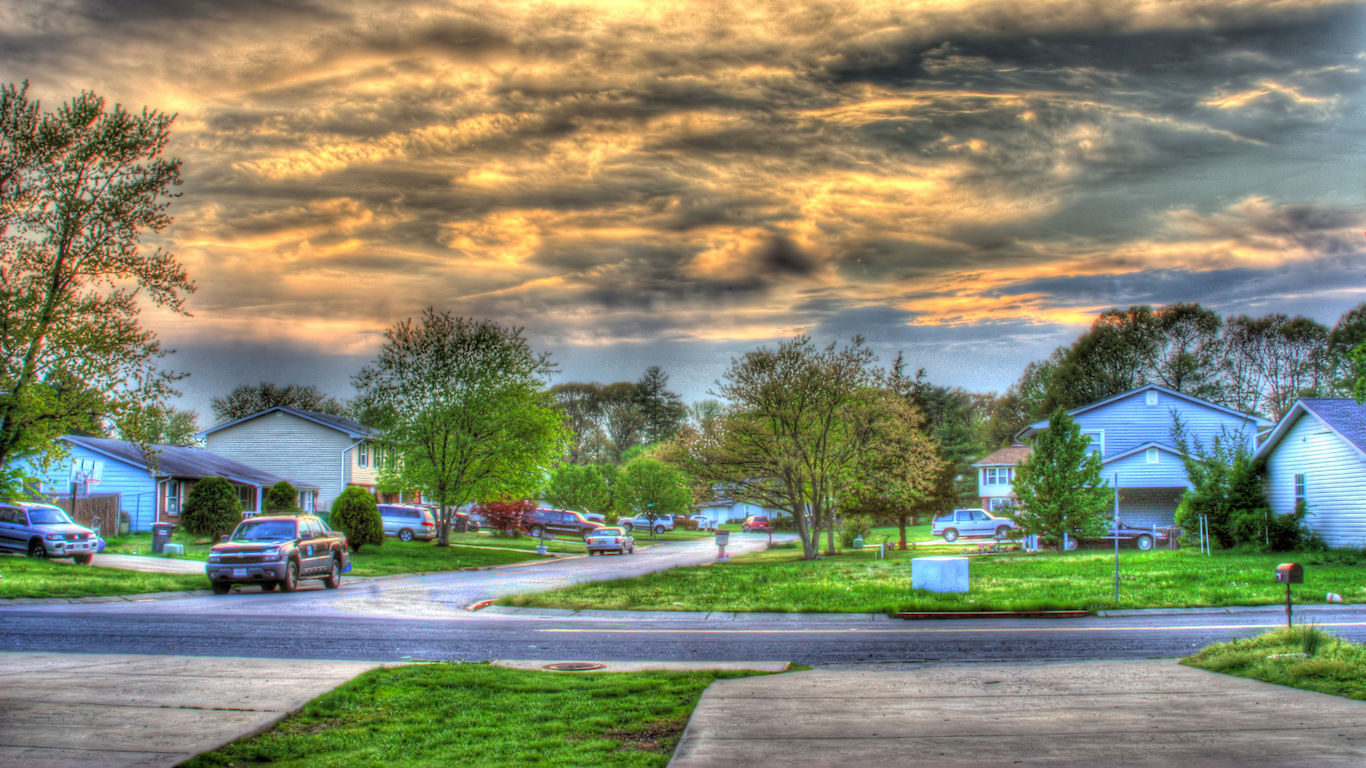
18. Waldorf, Maryland
> Population: 75,448
> Median home value: $276,900
> Poverty rate: 8.2% (bottom 25%)
> Pct. with at least a bachelor’s degree: 27.8%
Waldorf, Maryland is one of several Washington D.C. suburbs to rank among the best cities to live in. Not only do area residents have easy access to entertainment venues and cultural amenities in the nation’s capital, but also Waldorf itself has a greater concentration of restaurants and cafes than is typical nationwide.
Relatively few Waldorf residents are struggling financially. The typical area household earns about $96,900 a year. Additionally, only 8.2% of the local population lives below the poverty line, below the state and national poverty rates of 9.7% and 14.0%, respectively. High income areas like Waldorf are the reason Maryland is the wealthiest state in the country.
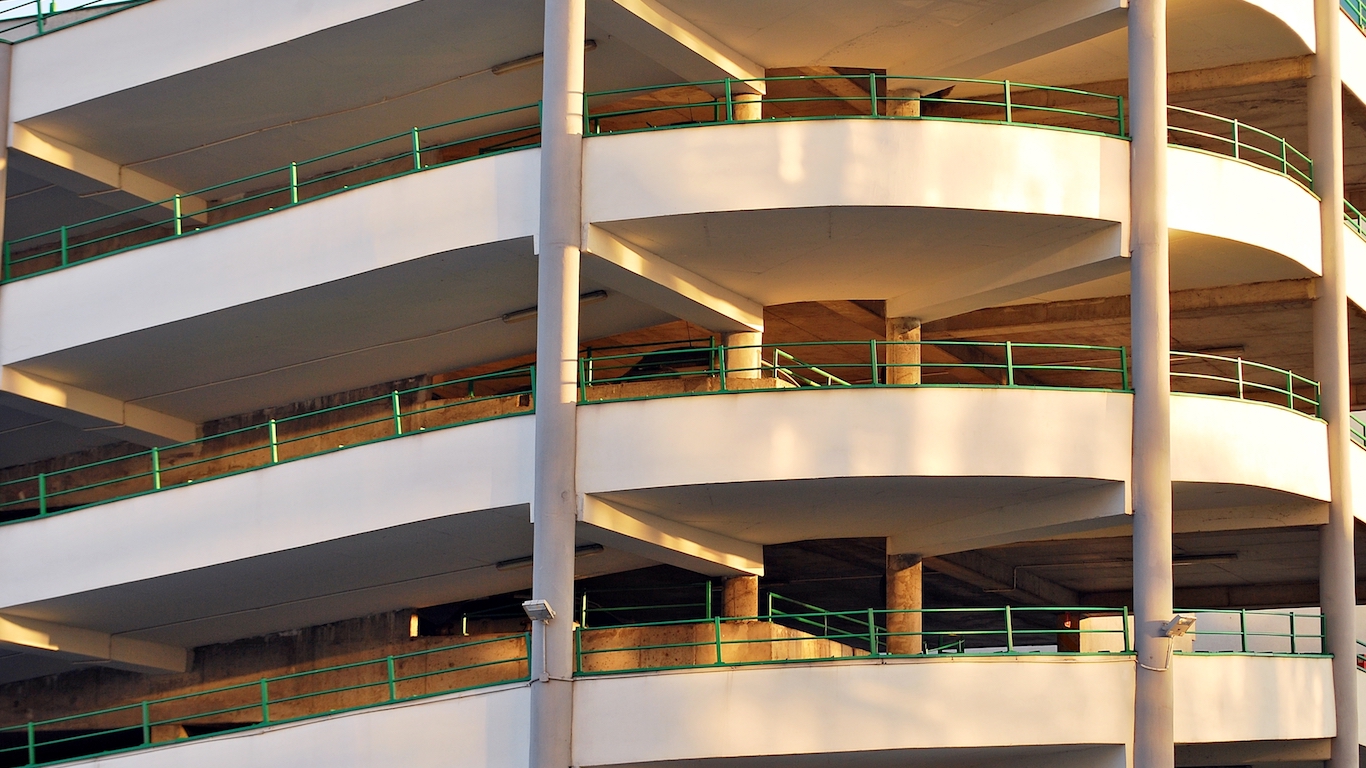
17. Hoover, Alabama
> Population: 84,943
> Median home value: $278,600
> Poverty rate: 5.4% (bottom 10%)
> Pct. with at least a bachelor’s degree: 57.7% (top 10%)
The wealthiest city in Alabama, Hoover is one of the best places to live in the United States. The typical Hoover household earns $79,004 a year, far more than the $57,617 a year the typical American household earns and the 112th most of any city. Adjusted for the area’s low cost of living — goods and services cost 9 cents less on the dollar in Jefferson County than they do nationwide — household income in Hoover is higher than in all but 51 other cities. Just 5.4% of Hoover residents live in poverty, compared to 14.0% of Americans nationwide.
While population growth in nearby Birmingham has lagged far behind the national growth rate over the past decade, Hoover’s population has grown faster than most U.S. cities. The Hoover population rose 17.0% between 2007 and 2016, more than double the 7.1% national rate.
[in-text-ad-2]

16. Frisco, Texas
> Population: 163,631
> Median home value: $369,900 (top 25%)
> Poverty rate: 4.3% (bottom 10%)
> Pct. with at least a bachelor’s degree: 65.9% (top 10%)
Frisco is a fast growing suburb of the Dallas-Fort Worth-Arlington metro area and one of the best places to live in the country. Over the past 10 years, Frisco’s population has increased by 73%, the third fastest growth of any city. Frisco is also one of the wealthiest cities in the country and has one of the lowest costs of living. The typical household in Frisco earns $124,829 a year, more than twice the national median household income of $57,617. Adjusted for the area’s low cost of living — goods and services cost 6 cents less on the dollar in Collin County than they do nationwide — Frisco households earn more than any U.S. city other than neighboring Flower Mound.

15. Arlington, Virginia
> Population: 230,050
> Median home value: $678,100 (top 10%)
> Poverty rate: 8.1% (bottom 10%)
> Pct. with at least a bachelor’s degree: 74.3% (top 10%)
The Washington D.C. suburb of Arlington is one of the wealthiest and best educated neighborhoods in the United States. The typical area household earns about $110,400 a year, more than enough to compensate for the area’s relatively high cost of living. Arlington is also one of the most educated cities in the country. High schoolers in Arlington test better than students in any city in Virginia other than Chesapeake and Centreville, and 74.3% of adults have at least a bachelor’s degree. By comparison, 31.3% of U.S. adults have completed four years of college.
The area’s hospitals also report some of the best outcomes in the United States. Combined, Arlington County’s two hospitals have lower mortality and readmission rates than the U.S. as a whole. Preventable hospitalizations in the area are about half as common as they are nationwide.
[in-text-ad]
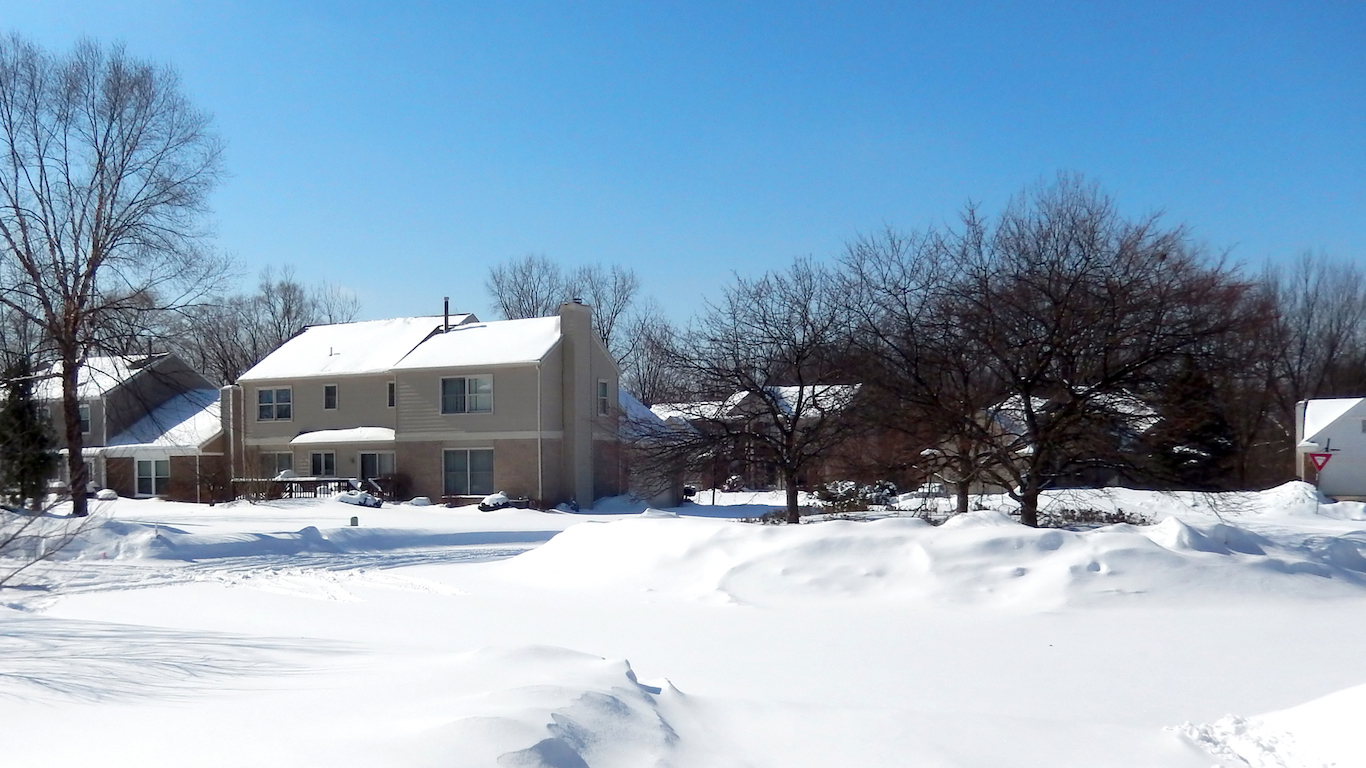
14. Rochester Hills, Michigan
> Population: 73,418
> Median home value: $294,200
> Poverty rate: 6.0% (bottom 10%)
> Pct. with at least a bachelor’s degree: 57.3% (top 10%)
One of the largest indicators of quality of life is education. High school students in Rochester Hills test better than students in any city in MIchigan other than Troy or Ann Arbor, and 57.3% of adults have at least a bachelor’s degree — far more than the 31.3% of adults nationwide.
Rochester HIlls is also largely devoid of the violent crime that plagues much of the Detroit metro area. There were 72 violent crimes reported per 100,000 residents in 2016, a fraction of the national violent crime rate of 386 incidents reported per 100,000 Americans. While in neighboring Detroit crime and economic decline have reduced the value of a typical home from $91,700 in 2006 to $43,500 today, homes in Rochester Hills have continued to appreciate. The typical home in the city is worth $294,200 today, an increase of $15,000 from 10 years ago and roughly $90,000 more than the U.S. median home value.

13. Flower Mound, Texas
> Population: 73,289
> Median home value: $344,300 (top 25%)
> Poverty rate: 4.7% (bottom 10%)
> Pct. with at least a bachelor’s degree: 61.3% (top 10%)
The typical household in Flower Mound, Texas earns about $131,500 annually, the sixth most of any city. After adjusting for the area’s low cost of living, the median income in Flower Mound is the highest of any U.S. city. Just as a large share of area residents are wealthy, very few face serious financial hardship. Fewer than 5% of the city’s population lives in poverty — less than a third of the statewide poverty rate.
Largely financially secure, Flower Mound residents are also generally safe from the threat of violent crime. There were fewer than 50 violent crimes for every 100,000 Flower Mound residents in 2016. In comparison, there were 434 violent crimes per 100,000 people in Texas and 386 per 100,000 people in the United States.

12. Gilbert, Arizona
> Population: 237,120
> Median home value: $307,000 (top 25%)
> Poverty rate: 5.0% (bottom 10%)
> Pct. with at least a bachelor’s degree: 45.4% (top 25%)
Gilbert is a town roughly 20 miles southeast of Phoenix, the largest city in Arizona. Many Gilbert residents hold advanced, high-paying jobs in Phoenix. The typical household in the town earns $91,576 a year, far more than the national median household income of $57,617. Commuters living in northern Gilbert might have access to additional transit options as soon as 2019, when the Valley Metro Rail completes the extension of its light rail service to an intersection just north of the city.
Like many of the best cities to live in, Gilbert’s population has grown at a rapid pace in recent years. Since 2011, the population has increased 11.9%, more than three times the 3.7% increase nationwide.
[in-text-ad-2]
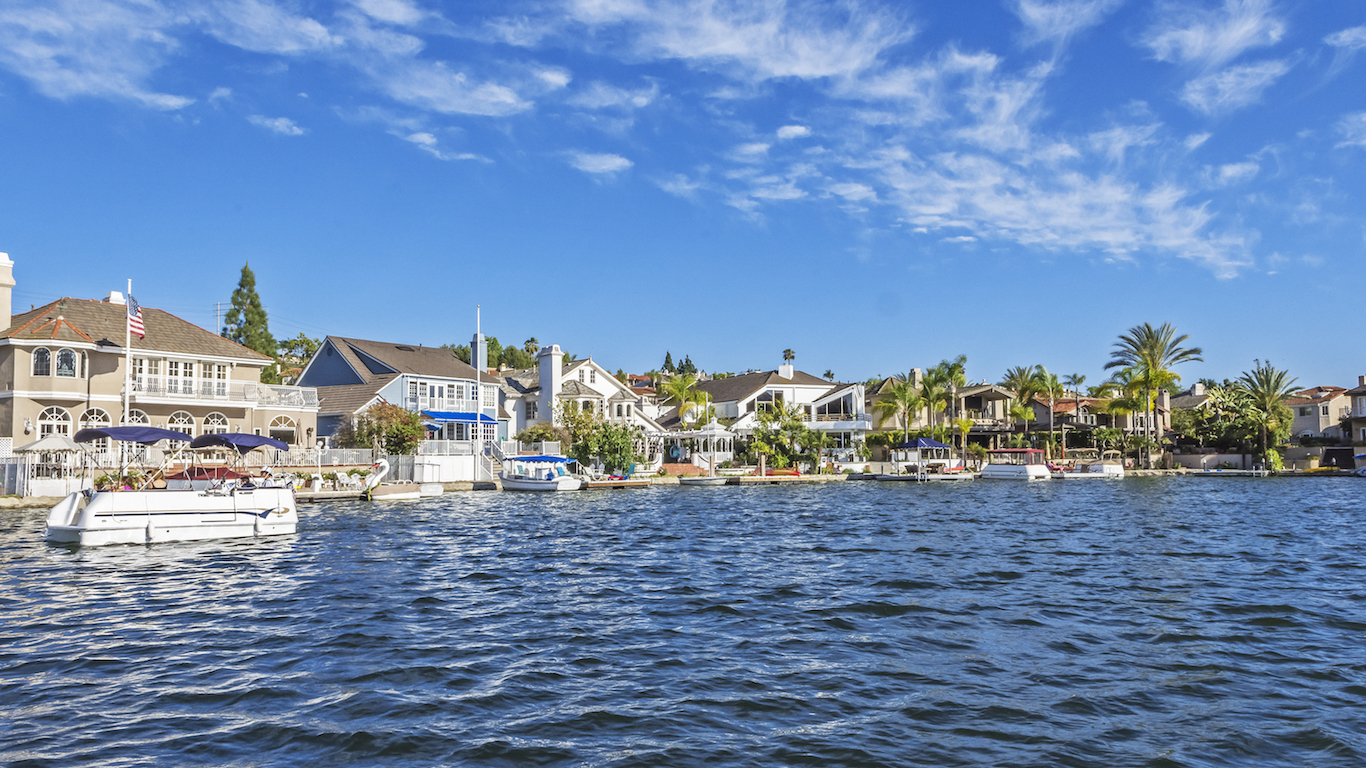
11. Mission Viejo, California
> Population: 96,386
> Median home value: $667,100 (top 10%)
> Poverty rate: 4.7% (bottom 10%)
> Pct. with at least a bachelor’s degree: 49.7% (top 10%)
Many Americans consider Southern California paradise. The average annual rainfall in Mission Viejo is less than 9 inches — a fraction of the national average of 37 inches of rain annually. Area residents are also largely untouched by the effects of neighborhood crime. There were only 78 violent crimes in the city for every 100,000 residents in 2016, far fewer than the 386 incidents per 100,000 Americans nationwide.
Living in Mission Viejo is not cheap, however. Goods and services in the city are 29.3% more expensive than they are nationwide, on average. Still, the typical area household earns about $111,500 a year, more than enough to compensate for the higher living expenses.
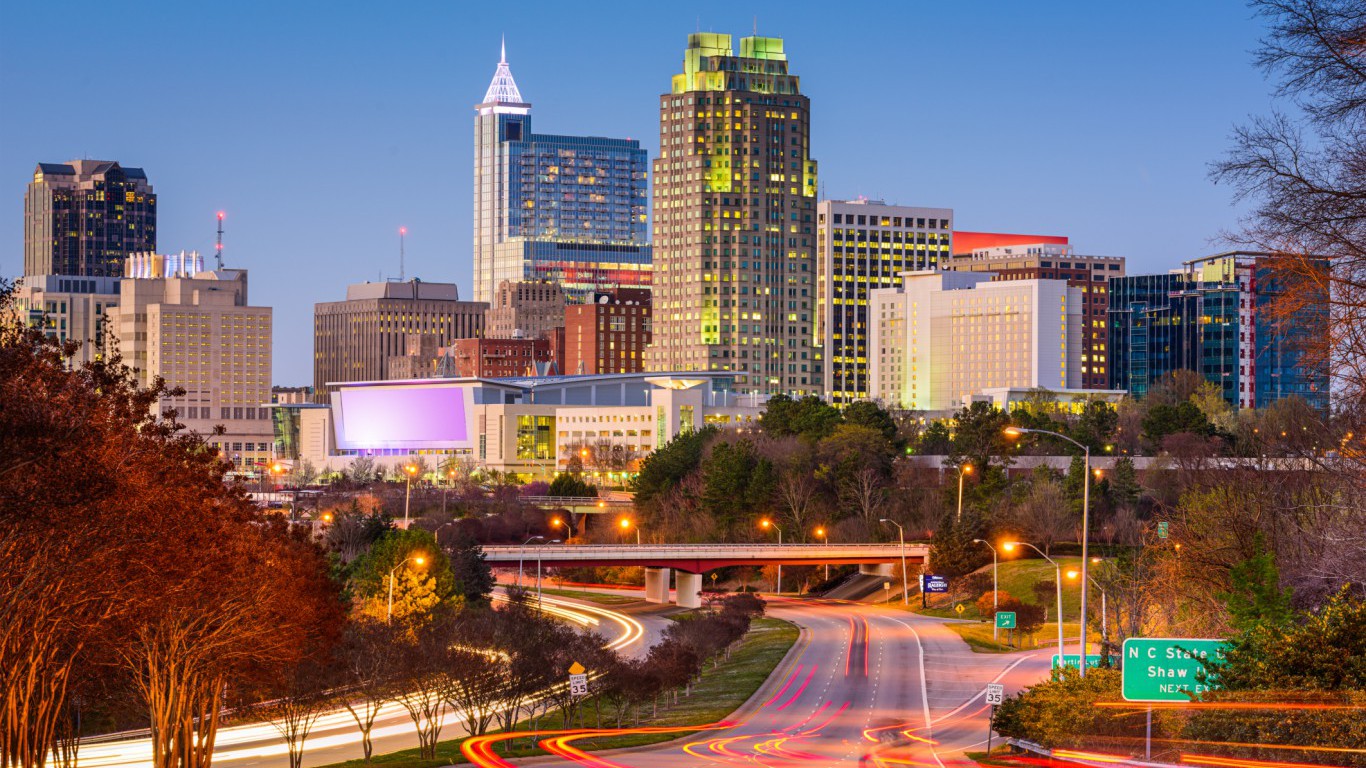
10. Raleigh, North Carolina
> Population: 458,862
> Median home value: $242,500
> Poverty rate: 12.1% (bottom 25%)
> Pct. with at least a bachelor’s degree: 50.8% (top 10%)
Raleigh is one of many fast-growing mid-size cities in North Carolina. Over the past 10 years, the population of Raleigh increased by 29.6%, the most of any city in the state other than neighboring Cary, and far more than the 7.1% national population growth rate.
Raleigh is located in the southeastern corner of the Research Triangle, a prospering area with three leading research universities and many high-tech companies. Raleigh itself is home to North Carolina State University and is a 30-minute drive from Duke University and The University of North Carolina at Chapel Hill. North Carolina has one of the largest brain gains — more college graduates are staying in the state than leaving — in the country. This has contributed to high educational attainment in cities across the state. In Raleigh, 50.8% of adults have at least a bachelor’s degree, far more than the 31.3% national share.
[in-text-ad]

9. Columbia, Maryland
> Population: 107,308
> Median home value: $371,400 (top 25%)
> Poverty rate: 6.5% (bottom 10%)
> Pct. with at least a bachelor’s degree: 63.2% (top 10%)
Cities like Columbia are largely the reason Maryland is the wealthiest state in the country. The typical Columbia household earns $107,164 a year — well above the median income nationwide of $57,617. As is the case in many of the best cities in the country, goods and services are considerably more expensive in Columbia than they are on average nationwide. Still, the area’s high incomes are more than enough to offset the high costs.
Columbia residents have access to plenty of cultural amenities and entertainment venues. The city has a higher concentration of restaurants, theatre companies, and movie theatres than is typical nationwide. Like many cities on this list, Columbia’s population is growing rapidly. The city’s population climbed by about 15% in the last 10 years, more than double the U.S. population growth over the same period.
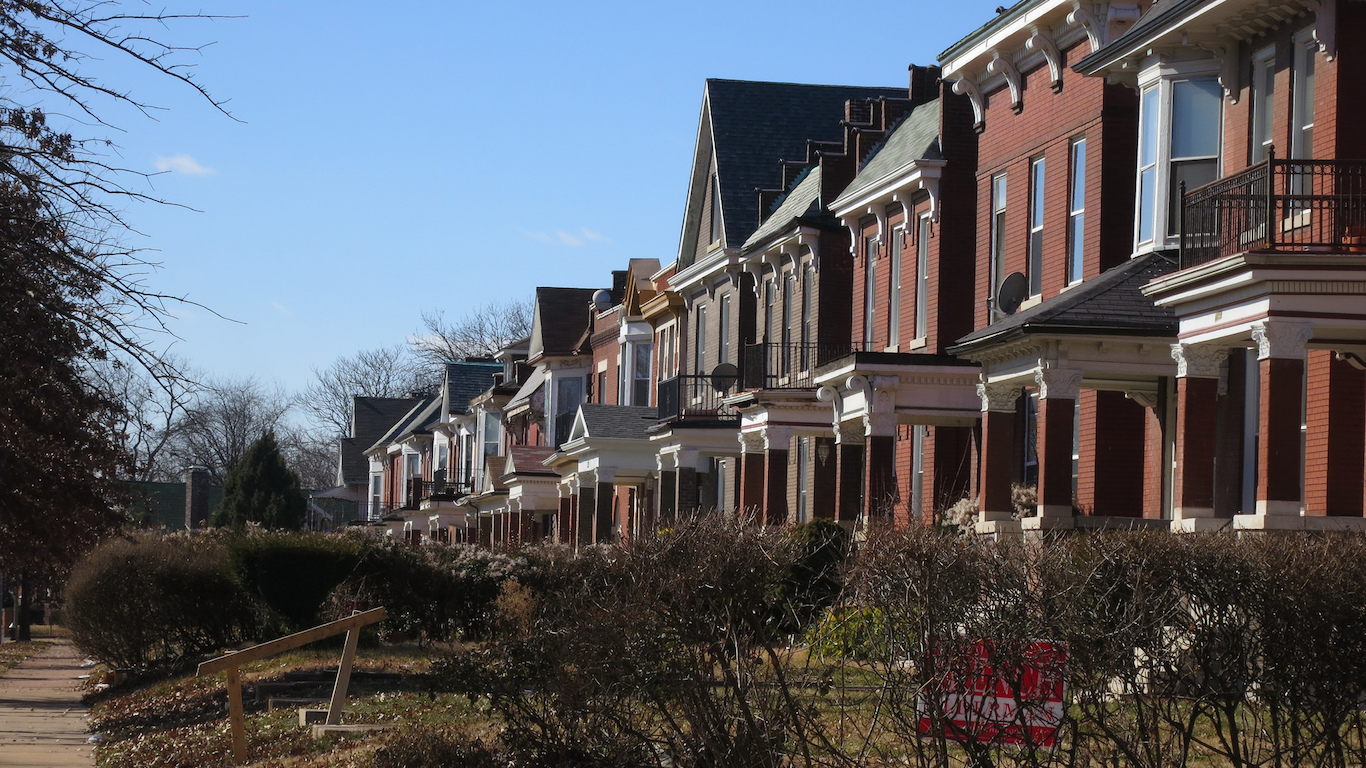
8. O’Fallon, Missouri
> Population: 86,276
> Median home value: $224,400
> Poverty rate: 3.3% (bottom 10%)
> Pct. with at least a bachelor’s degree: 43.0% (top 25%)
O’Fallon is one of the best places to live in the Midwest and in the country as a whole. That is partially because people living there tend to be relatively affluent. But while places where the population earns higher incomes tend to be more expensive, O’Fallon is relatively affordable. The typical household in O’Fallon earns approximately $85,000 annually. When adjusted for the area’s low cost of living, however, the value of the median household income is closer to $90,000.
Housing in particular is cheap in the city, which is located on the outskirts of the St. Louis metropolitan area. The typical home is worth about $224,000, only slightly more than the national median home value. While in some cities the price of a typical home can be as much as 15 times the median household income, in O’Fallon the median home value is just 2.6 times the annual earnings of the typical household.

7. Naperville, Illinois
> Population: 148,063
> Median home value: $421,400 (top 25%)
> Poverty rate: 4.1% (bottom 10%)
> Pct. with at least a bachelor’s degree: 69.2% (top 10%)
Naperville is one of the most educated of U.S. cities. Naperville high schoolers test better than students in any city in Illinois other than Arlington Heights, and 69.2% of adults have at least a bachelor’s degree — more than twice the 31.3% of adults nationwide with similar education. Many of the city’s most educated residents likely commute to high-paying jobs in neighboring Chicago. The typical Naperville household earns $116,482 a year, the 12th most of any city nationwide.
Naperville is largely devoid of the violent crime that plagues much of the Chicago metro area. In 2016, there were just 62 violent crimes reported per 100,000 residents in Naperville, far less than the national rate of 386 incidents per 100,000 Americans and among the least of any U.S. city.
[in-text-ad-2]
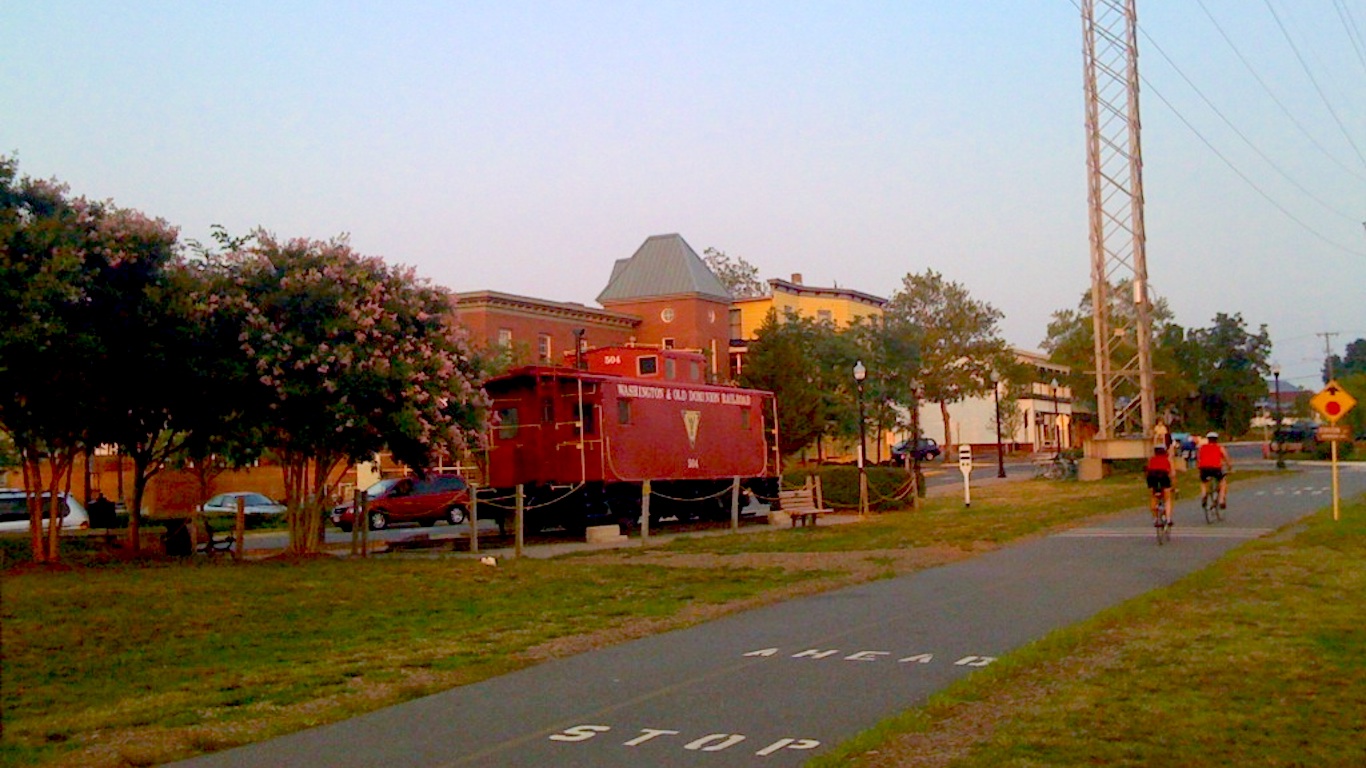
6. Dale City, Virginia
> Population: 72,073
> Median home value: $297,800 (top 25%)
> Poverty rate: 5.7% (bottom 10%)
> Pct. with at least a bachelor’s degree: 27.8%
Dale City residents have relatively easy access to the entertainment and cultural amenities of nearby Washington D.C. Many likely work in high-paying jobs in and around the nation’s capital. The typical Dale City household earns about $95,600 a year, nearly $40,000 more than is typical nationwide. Just as the area is home to a relatively large share of wealthy residents, very few in Dale City face serious financial hardship. Only 5.7% of the city’s population live in poverty, less than half the U.S. poverty rate of 14.0%.
Housing in the area is slightly more affordable than it is nationwide. While nationwide the typical home costs 3.6 times the U.S. median income, in Dale City the typical area home is worth about 3.1 times the city’s median household income.
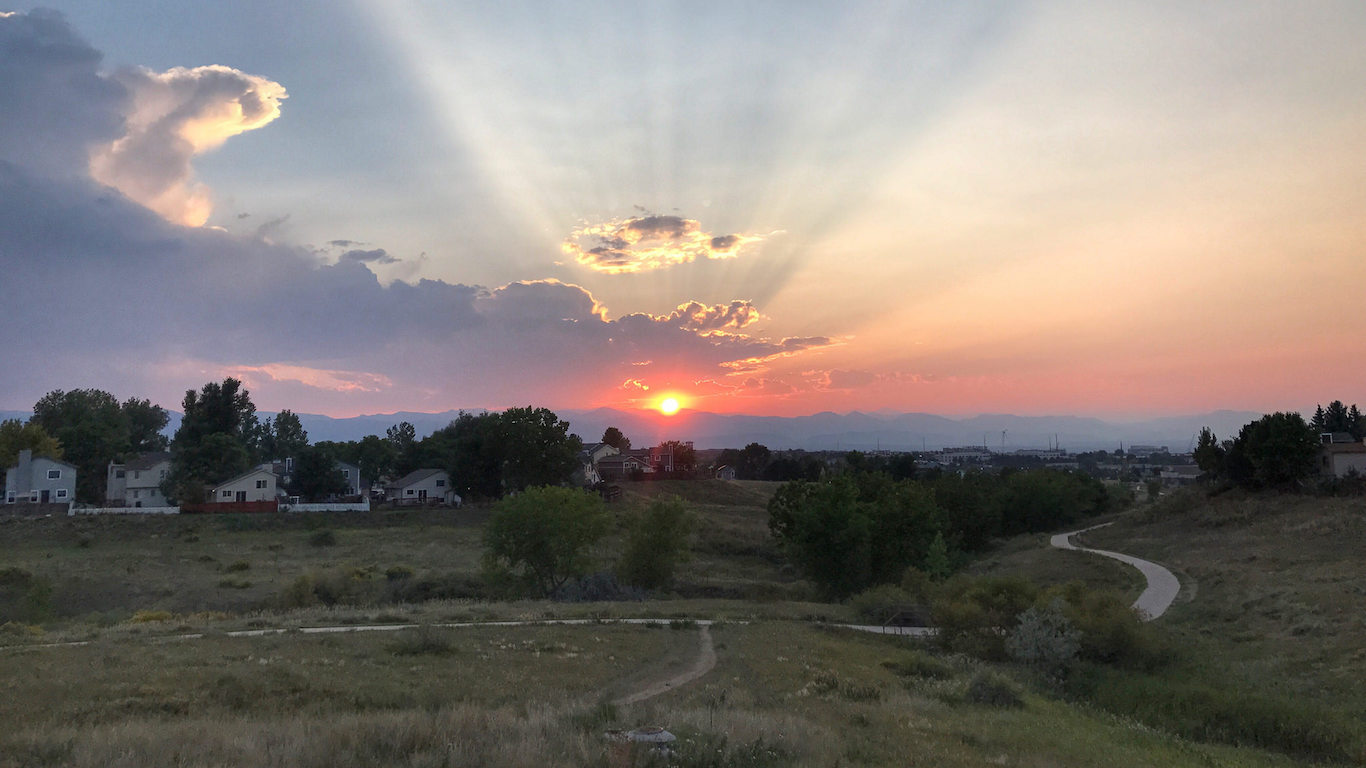
5. Highlands Ranch, Colorado
> Population: 112,436
> Median home value: $446,300 (top 10%)
> Poverty rate: 3.1% (bottom 10%)
> Pct. with at least a bachelor’s degree: 65.6% (top 10%)
Colorado’s population tends to be healthy, and Highlands Ranch has one of the healthiest populations in both the state and the country. A small number of preventable hospitalizations is a sign of both good health habits within a population and an efficient health system. Highlands Ranch, which is located about 40 minutes outside of Denver, only has about half as many preventable hospitalizations per capita as the nation as a whole. Similarly, the city’s hospital readmission rate, another indicator of public health and quality of healthcare, is one of the lowest of any major city.
Health is often a byproduct of affluence, and Highlands Ranch is one of the wealthiest cities in the country. The typical household earns $114,288 a year, or about double the national median household income.
[in-text-ad]

4. Johns Creek, Georgia
> Population: 83,884
> Median home value: $372,000 (top 25%)
> Poverty rate: 4.9% (bottom 10%)
> Pct. with at least a bachelor’s degree: 63.3% (top 10%)
The importance of a quality education is well documented — it can have wide-reaching effects on the lives of individuals both in terms of financial prosperity and personal well-being. Johns Creek has one of the best educated populations in the country. While 31% of U.S. adults have a bachelor’s degree, well over 60% of Johns Creek adults do. High schoolers in the Atlanta-region city also have the highest average test scores of any city in Georgia.
People living in Johns Creek also have access to a large number of amenities in the area. The city has one of the highest concentrations of restaurants, recreational centers, and movie theaters in the United States.
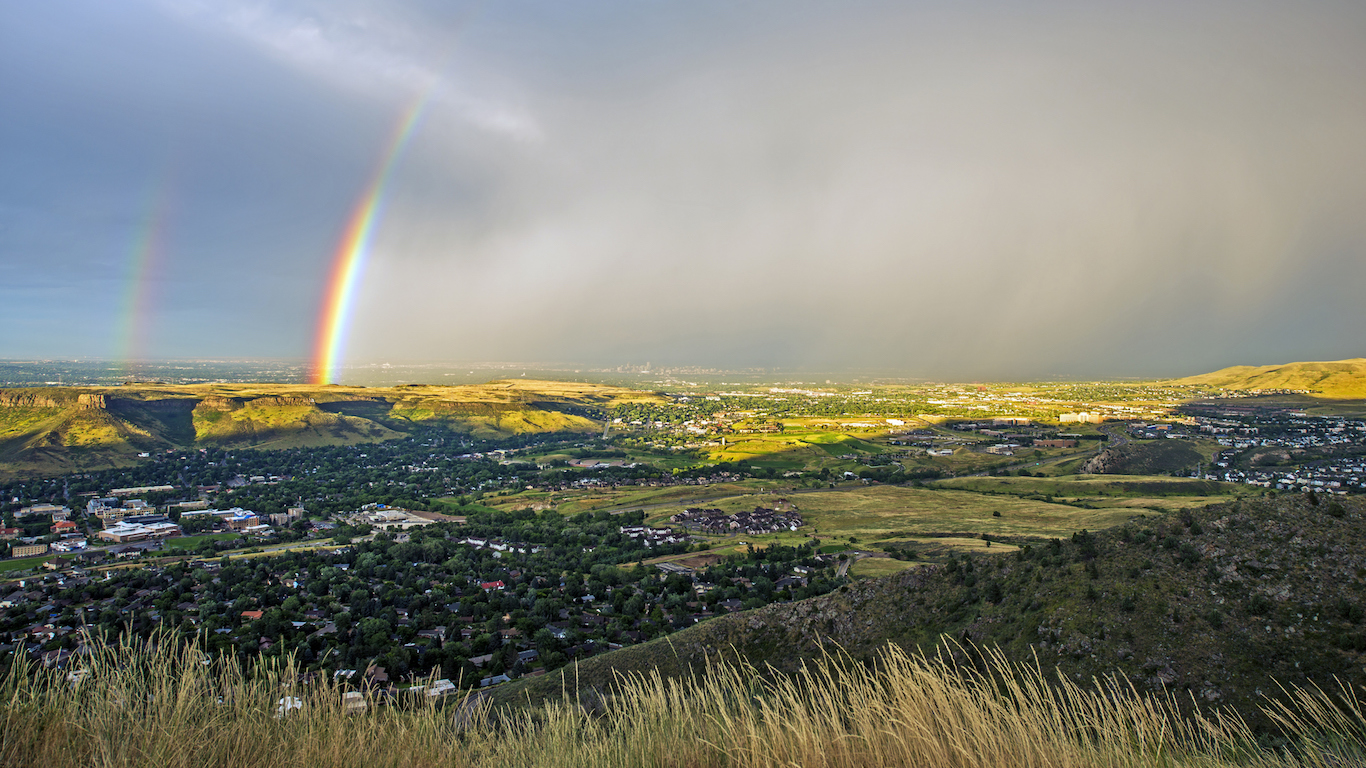
3. Arvada, Colorado
> Population: 117,308
> Median home value: $342,700 (top 25%)
> Poverty rate: 5.4% (bottom 10%)
> Pct. with at least a bachelor’s degree: 37.2%
A high violent crime rate can undermine the quality of life in any city. Arvada, Colorado is one of the safest cities in the country, with only 27 violent crimes for every 100,000 residents in 2016. In comparison, there were 386 violent crimes for every 100,000 people nationwide that year. Area residents are also largely financially secure. Only 5.4% of the Arvada population lives below the poverty line, well below the U.S. poverty rate of 14.0%.
As is the case with many cities on this list, Arvada residents have easy access to the jobs and cultural amenities of a major city. Downtown Denver is less than half-hour drive from Arvada.
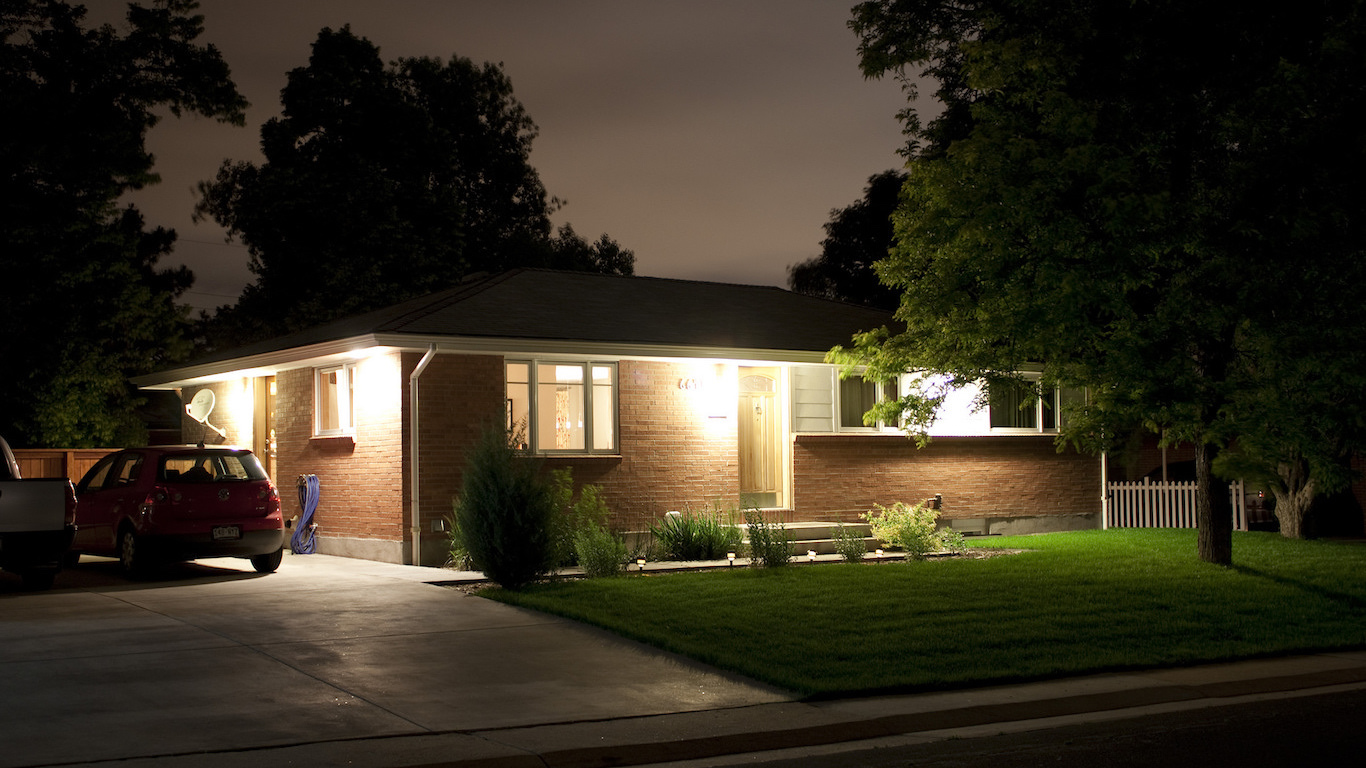
2. Centennial, Colorado
> Population: 109,935
> Median home value: $393,200 (top 25%)
> Poverty rate: 2.7% (bottom 10%)
> Pct. with at least a bachelor’s degree: 55.3% (top 10%)
Based on a range of socioeconomic measures, Centennial is the most livable city in Colorado and the second most livable in the United States. The city’s population has grown by 7.1% in the last five years, nearly double the U.S. population growth rate over that time. A low cost of living and high incomes contribute to widespread prosperity in the area. The typical Centennial household earns $102,200 a year, and only 2.7% of the population lives in poverty. In comparison, the typical American household earns only $57,617 a year, and some 14.0% of Americans live in poverty.
Centennial is also one of the safest cities in the United States. There were only 22 violent crimes for every 100,000 people in the city in 2016, a fraction of the U.S. violent crime rate of 386 incidents per 100,000 Americans.
[in-text-ad-2]
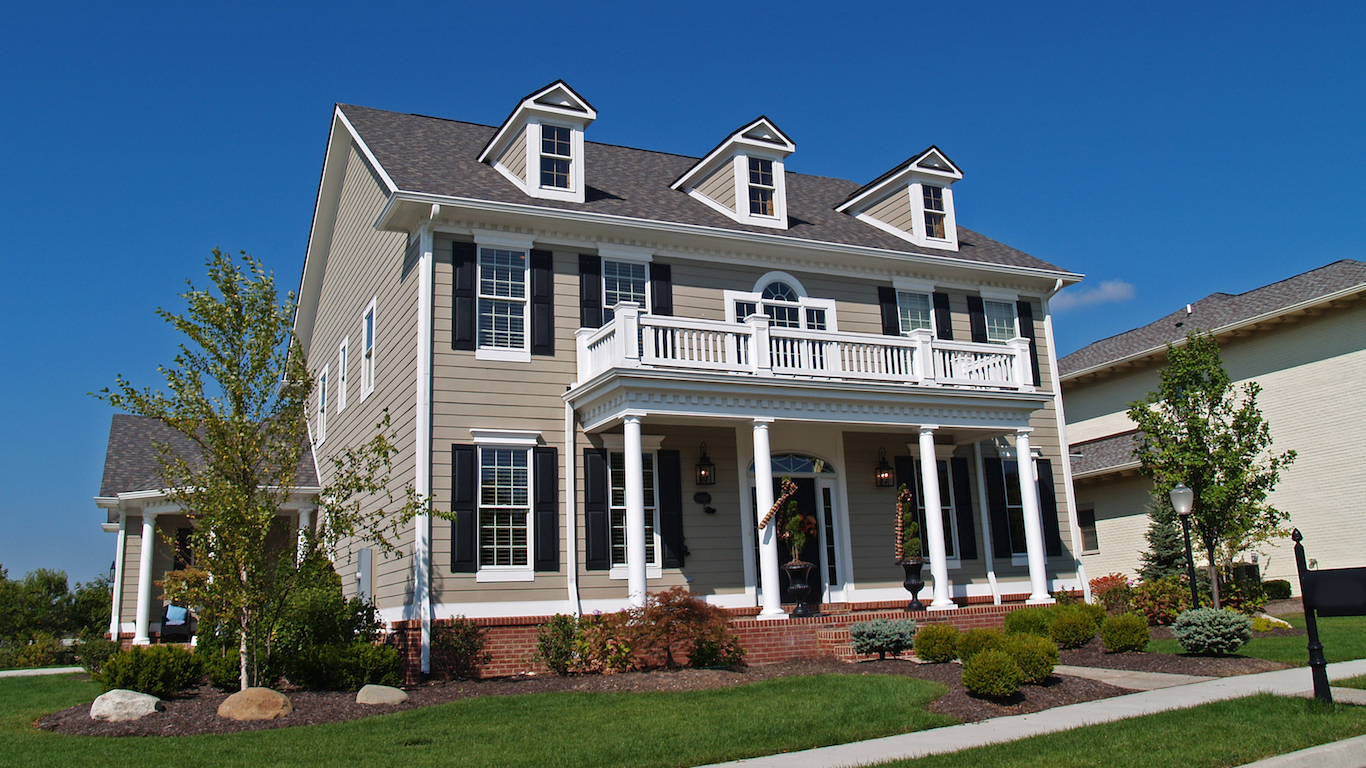
1. Carmel, Indiana
> Population: 90,533
> Median home value: $315,200 (top 25%)
> Poverty rate: 3.9% (bottom 10%)
> Pct. with at least a bachelor’s degree: 69.7% (top 10%)
According to 24/7 Wall St.’s analysis, there is no better city to live in the United States than Carmel, Indiana. People who live there are healthy, wealthy, and well educated — almost 70% of the adult population has a bachelor’s degree. Carmel is also one of the safest places in the country. Nationally, there are 386 violent crimes and 2,451 property crimes reported for every 100,000 residents. In Carmel, there are just 28 violent crimes and 887 property crimes per 100,000 people.
Carmel is also relatively inexpensive, making the already high incomes of its residents go even further. The typical household earns $113,194 per year, but because goods and services cost only about 90 cents on the dollar in Carmel compared to the national average, the effective median household income is equivalent to more than $125,000 when adjusted for cost of living.
Detailed Findings
A city’s vitality is often dependant on the strength of its economy. And a healthy economy often goes hand in hand with a healthy job market. For many Americans, job opportunities are the most important factor in choosing a place to live. The unemployment rate in only two of the 50 cities on this list with available data is higher than the nationwide 2016 jobless rate of 4.9%. Similarly, job growth in most of the best cities to live in was higher than average from 2014 through 2016.
Cities with strong, vibrant economies are less likely to have large shares of residents struggling financially. The poverty rate in only three of the 50 cities on this list is higher than the U.S. rate of 14.0%.
Educated populations are more resilient to economic downturns as a college education tends to lead to greater job opportunities and higher-paying jobs. Partially as a result, 42 of the 50 towns on this list are home to a larger share of college-educated adults than the 31.3% share of adults nationwide.
Just as solid employment figures can create a virtuous cycle of prosperity in U.S. cities, the presence of violent crime can be detrimental to a city’s livability, undermining growth. With only one exception, the violent crime rate in every city on this list for which data is available is lower than the U.S. rate as a whole. In Johns Creek, Georgia, for example, the fourth best city to live in, there were only 14 violent crimes for every 100,000 residents in 2016 — a fraction of the U.S. violent crime rate of 386 incidents per 100,000 people.
Desireable, vibrant communities are often expensive — prohibitively so for most Americans. Indeed, the cost of goods and services is substantially higher than the average cost nationwide in about a dozen of the cities on this list. Still, affordability is a major consideration for Americans who are looking to relocate. As a result, in about half of the cities on this list housing is more affordable than the nation as a whole, as measured by median household income as a percentage of the typical cost of a home.
A major contributing factor to a given city’s desirability is the presence of cultural amenities and entertainment venues. The majority of cities on this list have a greater concentration of restaurants and eateries or cultural amenities such as museums or theatres than is typical nationwide. Further, most of the best cities have relatively easy access to similar attractions in nearby major cities such as Denver, Minneapolis, New York, and Washington D.C.
Not surprisingly, the cities on this list are attractive to growing families and new residents. Well over half of the best cities have reported faster population growth over the last five years than the nation as a whole. None have reported a population decline.
Methodology
To determine America’s 50 best cities to live in, 24/7 Wall St. considered roughly 590 cities the U.S. Census Bureau reported as having populations of more than 65,000 in 2016. Only the top performing city in each county was considered in our ranking. Data were collected in nine major categories: crime, demography, economy, education, environment, health, housing, infrastructure, and leisure.
Within each category, specific measures contributed to a city’s overall category score. For example, the economy category included median household income adjusted for cost of living, the ratio between a city’s and its state’s median household income, poverty and unemployment rates, as well as a city’s three-year employment growth. Each measure was adjusted to range from 0 to 1 using min-max normalization, with lower scores indicating better outcomes.
Normalizing each measure, as opposed to aggregating category scores, allowed us to assign weight to individual measures to reflect their importance rather than entire categories. It also enabled us to expose the principal components of our index — those measures with wider variation that disproportionately determine the rank of a city’s composite score. The housing category, for example, had the widest range, giving it the greatest pull in our index. Crime and economy also had large variances.
We did not include any measures in the population change category in our composite index. However, this category provided exclusion rules. Cities that are better to live in often attract job seekers and their families. Conversely, labor market slack, unaffordable housing, high crime rates, or a myriad of other negative factors may induce people to move to a different city with better prospects. Thus, we excluded cities with negative five- or 10-year population growth rates. Population figures are from the Census Bureau’s 2016 American Community Survey (ACS).
The crime category consists of both violent and property crime rates from the Federal Bureau of Investigation’s 2016 Uniform Crime Report. Cities with crime rates lower than the national rates were rewarded, while cities with higher crime rates were penalized.
A strong economy and the health of a labor market are, for some, the only considerations when determining where to live. The economy category includes a city’s 2016 unemployment rate and employment growth from 2014-2016, both from the Bureau of Labor Statistics. Additionally, we considered the area’s poverty rate. Cities were penalized for having poverty rates above the national rate of 14.0%. Our goal was to identify cities that were liveable for everyone, not just the rich. Still, if incomes are too low, a city may not be desireable. To that end, we adjusted median household income for cost of living in the city. Cities were penalized if cost-adjusted incomes were less than $44,000 or more than $112,000 a year — roughly 80% to 200% of the median household income nationwide. Poverty rates and median incomes came from the 2016 ACS. Cost of living data came from property and real estate data provider Attom Data Solutions.
A strong school system may be another consideration for parents looking to move. As a proxy for school system strength, we considered high school standardized test scores relative to state scores from Attom Data Solutions. Test score data are for 2016 or the most recently available year. Additionally, the education category included the percentage of adults with at least a bachelor’s degree from the ACS as well as the number of colleges and universities in a city per 100,000 residents from the Department of Education. Both measures are as of 2016.
For people who like being outdoors — either for work or pleasure — a city’s air quality and weather may be of chief importance. Whereas other measures in this index are specific to an individual city, many metrics in this category describe the county in which the city is located because weather is likely similar, if not the same, in these two geographies. In this category, we included an air quality index to assess the levels of a variety of pollutants on a given day. Additionally, we considered an index measuring natural hazard risk as well as average monthly rainfall. All data in this category came from Attom Data Solutions.
Access to quality hospitals is another benefit of a desirable city. From the Centers for Medicare and Medicaid Services (CMS), we calculated 30-day risk-adjusted mortality rates of heart attacks, COPD, heart failure, pneumonia, and stroke. Also from CMS, we examined the rate at which individuals were readmitted to a hospital within 30 days of being discharged. This category also includes preventable hospitalizations — the share of hospitalizations that could have been treated with outpatient or ambulatory care for every 1,000 Medicare recipients from County Health Rankings.
For many American homeowners, their houses constitute the vast majority of wealth. An investment of this magnitude requires careful consideration and may be the chief reason that people decide to live where they do. In our housing index, we considered the ratio of a city’s median home value to the statewide median home value. Cities were penalized if a city’s median home value was worth less than 90% of the statewide median home value. Conversely, if home values were typically 25% higher than across the state, high barriers to entry exist that can make a city unaffordable. As an additional measure of affordability, we included the ratio of median home value to median annual household income. This ratio — called a price-to-income ratio — helps identify cities that are liveable for a broad audience. We also considered median property taxes as a percentage of median home value. All data in this category came from the 2016 ACS.
Proximity to work places may be another factor in determining where to live. According to the Texas A&M Transportation Institute, Americans waste nearly 7 billion hours — or $160 billion — due to commuter traffic congestion. From the ACS, we considered the percentage of commuters travelling to work by foot or public transportation. Additionally, we reviewed the average time it takes to travel to work each day. Lastly, we included the number of airports in the metro area in which the city is located. There are, for example, no airports in New York County, the primary county of New York City. However, at least three major airports exist outside county limits — and within the metro area — that service people who live in the city. Airport data came from the Federal Aviation Administration and only considers operational public-use and commercial airports as of 2016.
The leisure category can be broken into two parts: activities that take place in the city and outside of it. Within a city, residents may take advantage of restaurants and bars, libraries and archives, theater companies, fitness and recreational sports centers, museums, movie theaters, hotels, or amateur and professional sports teams. To engage in other pastimes — skiing, for example — residents likely have to leave city limits. Thus, we included in this index the number of zoos, nature parks, ski resorts, and golf courses in the counties surrounding the city. All data in this category was aggregated to the city level from 2014 Zip Code Business Patterns, a program maintained by the Census and adjusted for the city’s 2016 population.
If you missed out on NVIDIA’s historic run, your chance to see life-changing profits from AI isn’t over.
The 24/7 Wall Street Analyst who first called NVIDIA’s AI-fueled rise in 2009 just published a brand-new research report named “The Next NVIDIA.”
Click here to download your FREE copy.
Thank you for reading! Have some feedback for us?
Contact the 24/7 Wall St. editorial team.